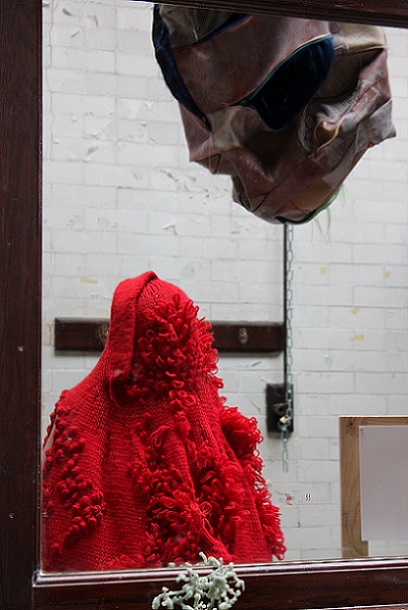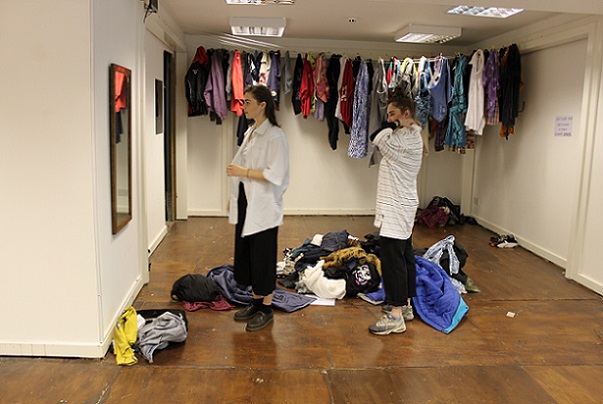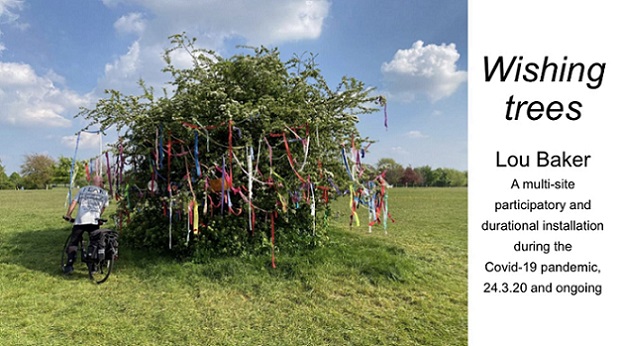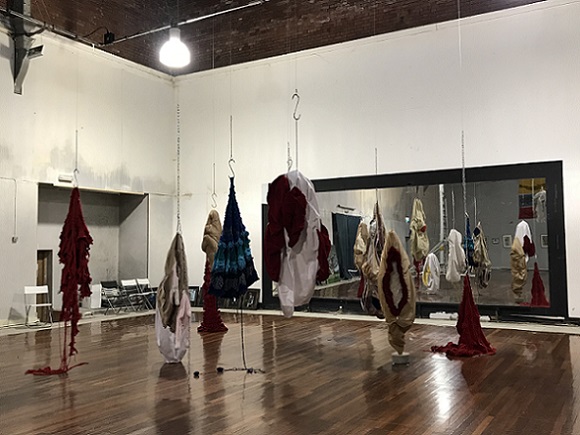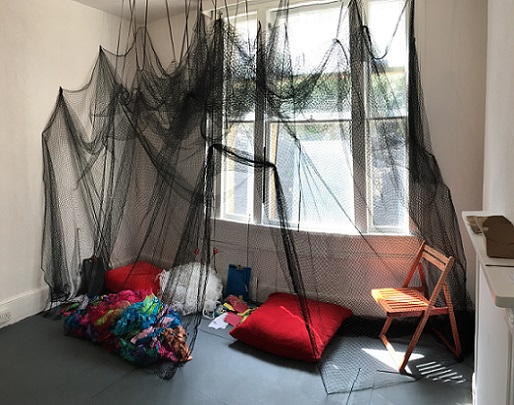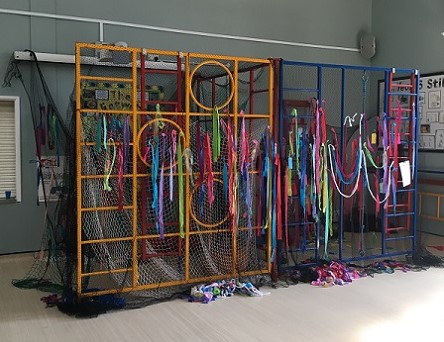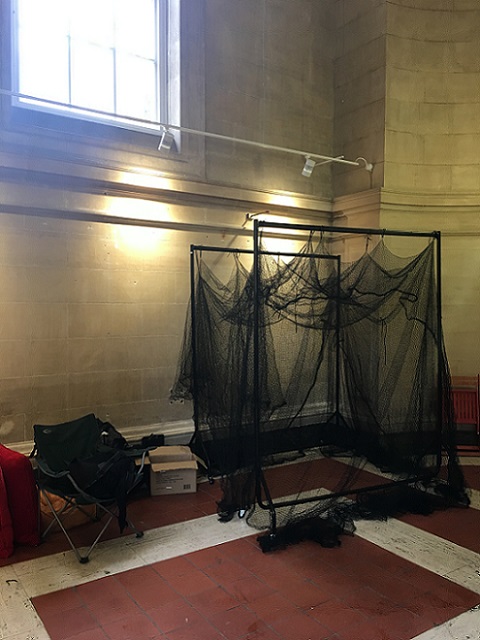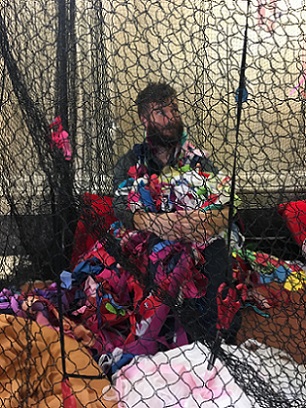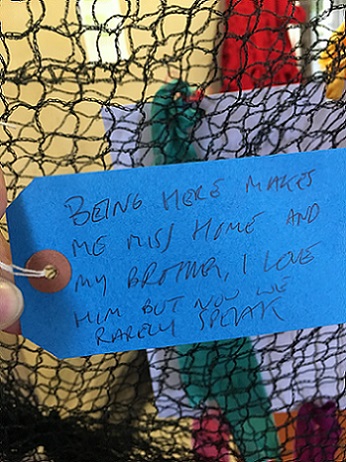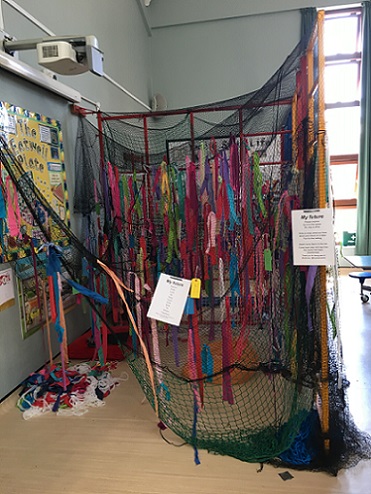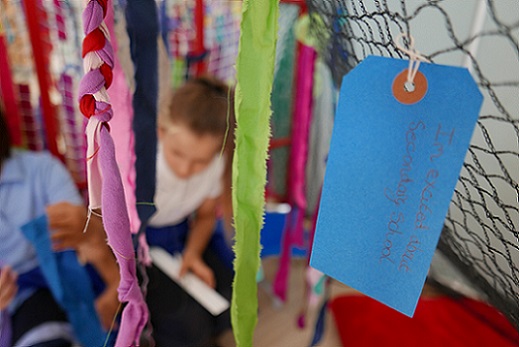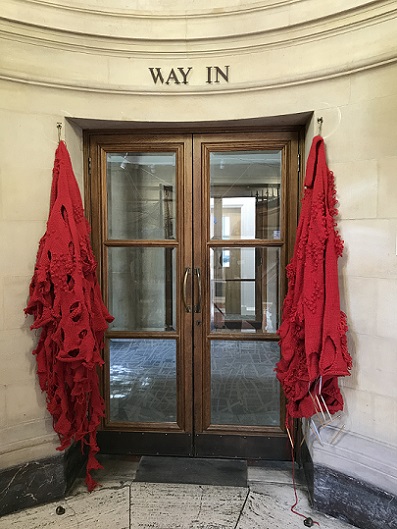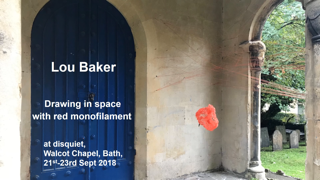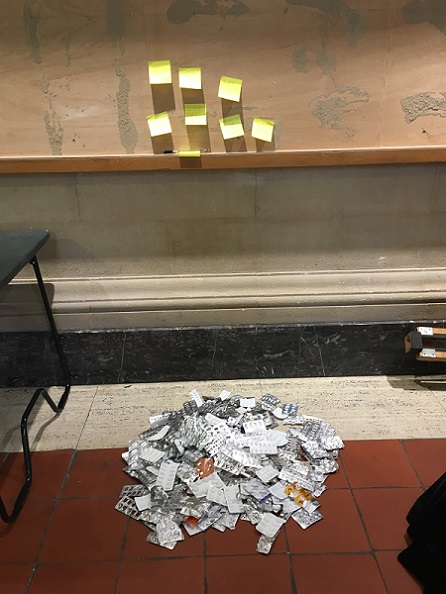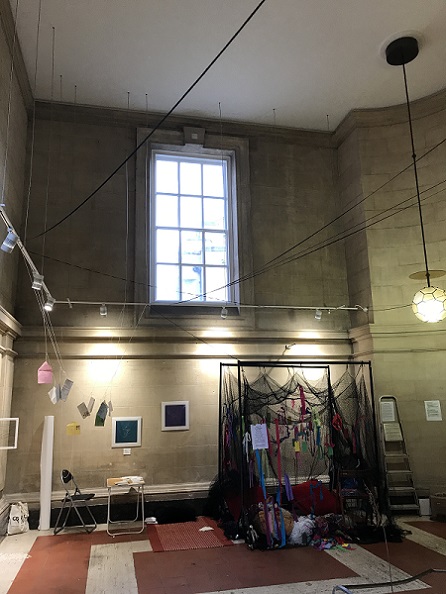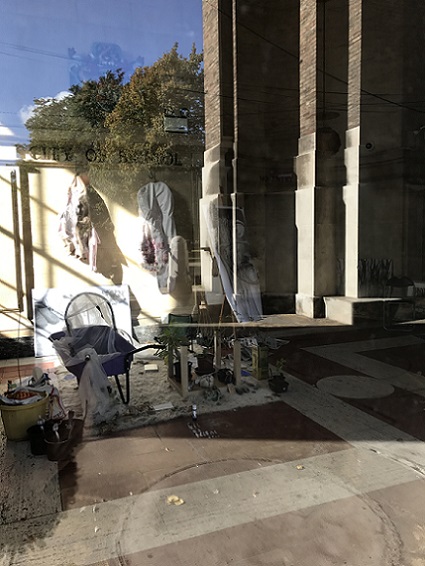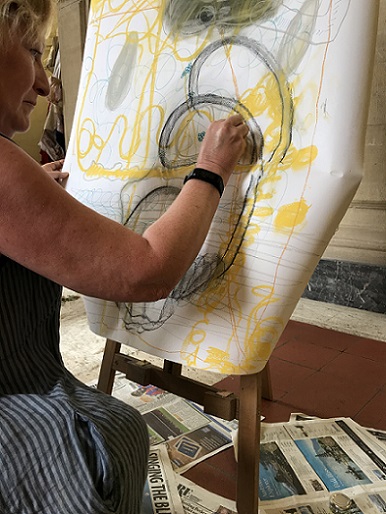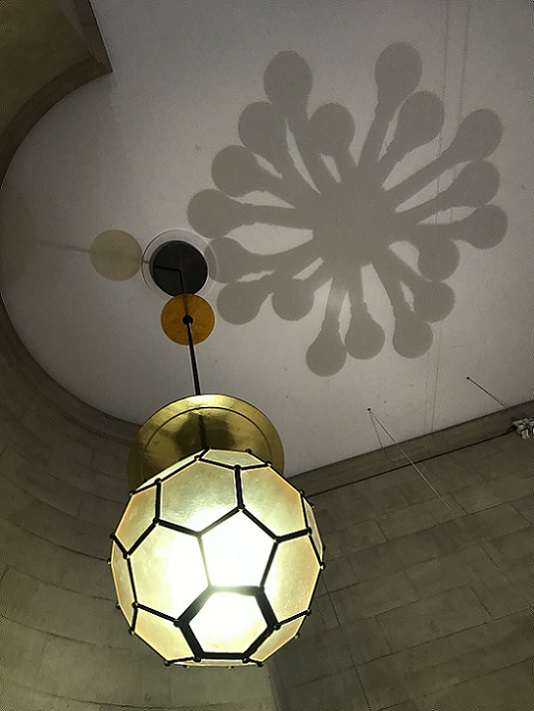For more performances, further images and information, please scroll down.
Feb 2018 and ongoing, I knit therefore I am
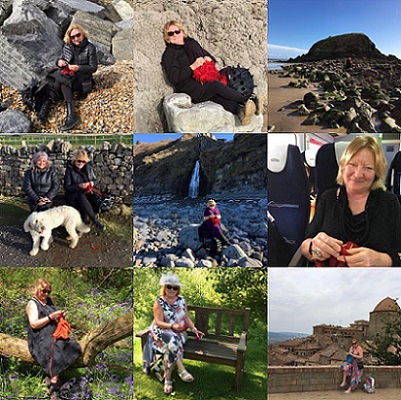
A montage of me knitting in public for World Wide Knit in Public Day, June 9th 2018
I find it hard to categorise I knit therefore I am, 2018. It isn’t a performance, yet it is performative; I do genuinely knit whenever and wherever I can. It is about knitting, but it isn’t about one soft sculpture. This is a sequel to I knit therefore I am, 2012, which is documented further down this page. Then, it was a project for University, led by me; this time, it's a series of images of me knitting in public, taken by my partner, Dave. Although the 2012 series is here, this time I’ve decided to categorise it as knitting, so for more details please visit my Knitting page.
1. Barafundle Bay, Pembrokeshire, 16.2.18
2. Overlooking Caldey Island, near Tenby, Pembrokeshire, 16.2.18
3. Saundersfoot, Pembrokeshire, 17.2.18
4. Worm's Head, Gower, with Lucy and Wolfie, 10.3.18
5. Bucks Mills, North Devon, 25.3.18
6. Rottingdean, West Sussex, 31.3.18
7. Worthing, West Sussex, 1.4.18
8. Priors Wood, Portbury, near Bristol, 5.5.18
9. Buckingham Palace garden party, 15.5.18
10. Volterra, Tuscany, Italy, 29.5.18
11. My I knit therefore I am montage for World Wide Knit in Public Day, 9.6.18
12. My Instagram post for WWKIPD, 9.6.18
13. Winner!
September 2016, Don't wash your dirty laundry in public at Synecdoche's Bodies residency at The Unit, Bristol
This participatory installation had some very distinctive performative elements to it. Have a look at my blog post, Free clothes, conversations and a washing line, for my reflections about that and also look at the documentation I made of the process, Don't wash your dirty laundry in public.
June 2016, Wearing the unwearable, Heart of darkness I at Privy at The Edwardian Cloakrooms, Bristol
May 2015, Wearing the unwearable, The Others; a self-portrait
'In its relationship with dress, the body is an eminently osmotic shell: when we adopt certain garments we do not confine ourselves to knowing their qualities and attributes, since, through direct physical contact we also assimilate them, we make them our flesh.’ (Cavallaro and Warwick,1998, in Simonson, 2008, p217, their italics)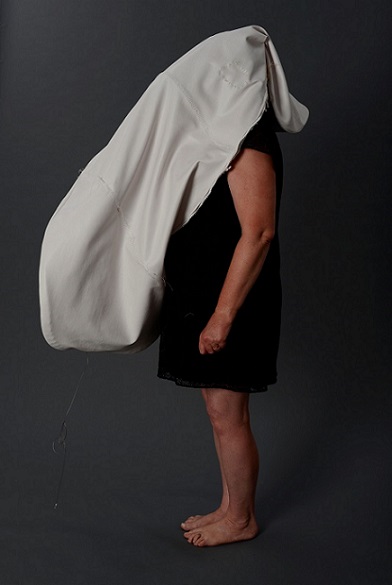
Other 1, Wearing the unwearable, 2015
For several years I have been exploring the body, more specifically, my body, through soft sculpture. In the process of making, I always have an irresistible desire the wear my work at various stages. I begin to see these episodes not only as ‘fittings’ but also as part of the embodiment; making them me. Some of these moments are captured with a camera, but as I normally work alone, more often they are not. With The Others, I decided to arrange a photo shoot in a studio, as this aspect of my work seems to be becoming more and more significant.
The links between garment and body are clear. The art theorist, Anne Hamlyn, refers to the clothing we wear as a ‘surrogate skin, a body at one remove’ (Hamlyn, 2000, p.42). From my teens to my thirties I delighted in designing and making all my own clothes. Although I must have been taught by my mother and grandmother, my inspiration came from my two older sisters and financial necessity. These skills also enabled me to express myself. It was very pleasing to wear clothing that nobody else wore, so I developed my own idiosyncratic style as I developed my identity. It has only been relatively recently that I have begun to realise that the garment making skills I have taken for granted for so many years transfer readily to a fine art setting.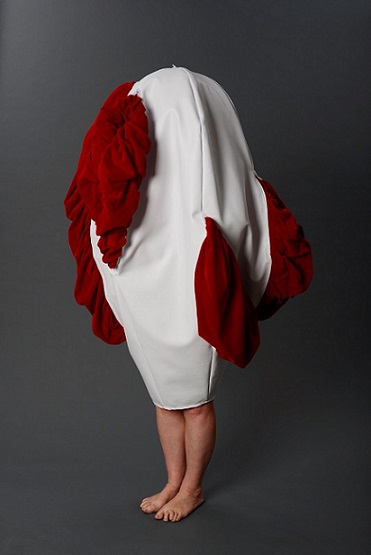
Other 2, Wearing the unwearable, 2015
For a while I have been recognising that these troubling, abstract forms are a form of self-portrait, so wearing them seems obvious. Although I had worn them at various points whilst making them, it felt very different, and quite thrilling, to wear them with an audience, albeit, an audience of 2 and in front of a camera! It was intriguing. I felt they became part of me; living, moving sculptures. I had found the perfect way to animate my work. My Frankenstein’s monsters.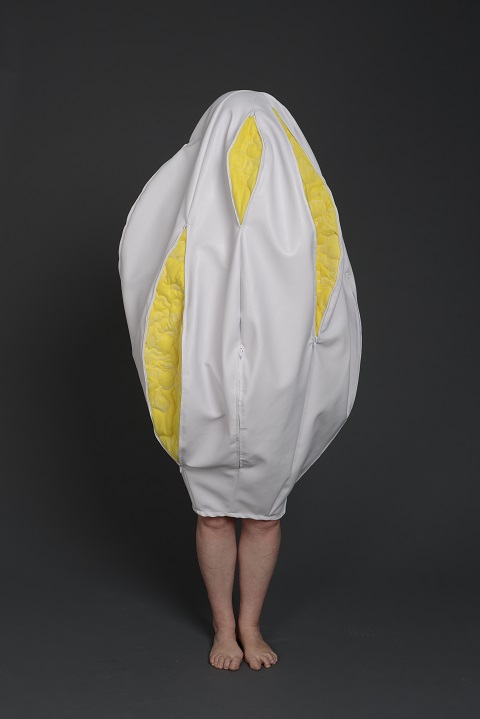
Other 3, Wearing the unwearable, 2015 I have exhibited this image as a framed A1 fine art print.
Although I am generally ambivalent about framing my work,
I think this works well and makes it accessible to more viewers.
I begin to see my sculptures as shrouds or body bags for different aspects of me, my multiple selves, which reveal and conceal elements of what lies within through the zipped openings. It is no coincidence that they are my size and shape. It is an idea I have visited in my work before. It explores the identity that nobody sees, and the idea that middle age brings invisibility. The inability to breathe, claustrophobia, loss of control and consequent rising panic when I was zipped into Others 2 & 3 also mirrors the change in control as my body begins to let me down.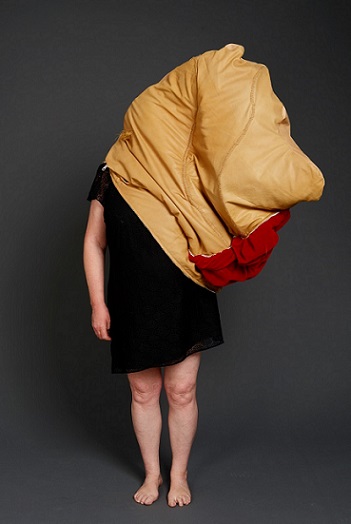
Other 4, Wearing the unwearable, 2015
By the time I did the photoshoot, all the sculptures were stuffed and finished so some of them were utterly unwearable. In practical terms, they would be impossible to wear independently! Deprived of air, sight and unable to move properly or remove them, I became totally dependent on my assistants. 
Other 5, Wearing the unwearable, 2015
I feel this series of images offer a very poignant take on identity, vulnerability and hiddenness. They is also something uncomfortably comical about them. Maybe it is the contrast of conflicting responses that makes them work so well? The shoot has totally changed my relationship with the work. It has made them much more intimate; now I see them from the inside as well as the outside.
Select bibliography
Cavallaro, D. and Warwick, A, 1998, Fashioning the Frame, Oxford: Berg in Simonson, Caryn, 2008, ‘Introduction’ in Textile, Volume 6, Issue 3, pp.216 – 221
Hamlyn, Anne, 2000, ‘Textures of Memory’, n.paradoxa 6 pp40-43 in Hemmings, Jessica, 2008, ‘Grown fashion: animal, vegetable or plastic’ in Textile, Volume 6, Issue 3, pp262 -27
2015, Wearing the unwearable, Nobody 3
I knitted Nobody 3 in 2014 but was interested to photograph it as part of my Wearing the unwearable series so I took it along to the photoshoot too. I love the flexibility of the knitted fabric, the way it drapes around me, but also moves with me. I think the very close associations with knitted garments makes it particularly poignant....but obviously I am still essentially hidden.
For more images and information please visit my Knitting page.
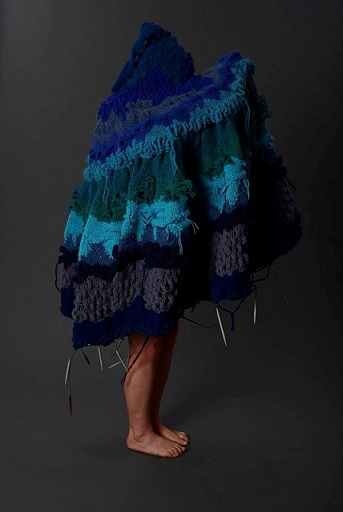
I have exhibited this image as a framed A1 fine art print.
Maybe it will mean that I won't actually have to perform live?


It had been worn before though….

Maura wearing my wave, Oct. 2013
Me wearing Nobody 3 al fresco
May 2012, Wearing the unwearable, Plastic surgery,
Cabot Circus, Bristol, 3rd May 2012, 4.30-5.30pm
Images courtesy of Jonny Baker
I am a reluctant performer, but I was challenged by my University tutor to wear Plastic Surgery whilst shopping in central Bristol. I spent an hour in one of Bristol’s busy shopping centres being photographed by Jonny as I shopped and walked around.
The public response:
I was surprised as I had very little response. Many people turned to stare or looked me up and down; some pointed and smiled or laughed but only one person made a comment and no one asked me why I was wearing a stuffed, multi-coloured garment sculpture!
Ladies toilet: The young woman cleaning and 4 or 5 other women looked at me as I put the sculpture on and quickly looked away. They then ignored me.
Cabot Circus security guard: As I came into the covered space outside the toilets a security guard looked at me and then kept looking back when I was on the escalator.
La Senza: I went in to look at the bras and a member of staff came over to me instantly. I told her I was doing an art project but she ignored that and started telling me how the underwear was arranged and told me which drawer to look in for XS briefs! I wish.
A group of young women looked me up and down, staring, with no smiles.
Topshop: The security guard went over to speak to another member of staff as soon as I walked in and pointed me out. They then watched me till I left.
Sainsbury Local: I bought a cereal bar and the young woman who served me made absolutely no response. She asked me if I wanted a bag and said ‘Have a nice day’ as I left.
Man on the Sky stand: I asked him for directions and he made no comment about my sculpture but politely suggested I ask at the Information desk.
Photo exhibition: I went into an art gallery to look at a photographic exhibition. There were two people in there who looked at me but then ignored me.
Outside Curves: A guy walked past, smiled at me, and said ‘Different!’
My response:
I was surprised at how much I enjoyed myself, overall. I was very self-conscious to begin with and found it hard to make eye contact or interact with the people around me. However, after a while, I began to forget what I was doing and settled into the rhythm of shopping. I found it very entertaining, seeing people watching me and then quickly looking away, but it was also very embarrassing. I didn’t see anyone I know, which was a relief at some levels.
I was also very relieved when I could finally take off the garment sculpture and be my normal self again. I was ridiculously pleased that I had done it.
Evaluation:
I think if I had been bolder or if I had been behaving in a more unusual way I would have had a better response. It was also quite quiet and I wonder if repeating the process on a Saturday afternoon, or elsewhere would have different results. Performing in other places might also get more response. I wondered about trying different areas of Bristol, my local High Street, a supermarket, a small village, a pub, a bus, Bower Ashton, a gym… the list is endless.
I could have set up some way of interviewing people or given out leaflets and asked for a response but I’m not sure I want to! I still feel very ambivalent about performance art generally and more specifically, about me performing.
If I had seen someone wearing what I was wearing I would have been intrigued but I too would probably have looked, smiled and turned away. I would have wanted to find out more, but would probably not have asked.
As city dwellers we are used to witnessing interventions and unusual happenings. We are conditioned to not respond or interact. My son, who works in Tesco, says that people doing unusual things often come in to the store and the staff are trained to ignore them, so they do!
Physical and conceptual changes:
Deciding to wear the sculpture has changed it, both physically and conceptually:
I knew that wearing it could damage it as the plastic is fragile in places but I liked the idea of performance creating change. I decided to alter it slightly by stitching the shoulder seams and one side seam. I then added some Velcro to the other side seam. It has made it more wearable and has only subtly altered the aesthetics. It now no longer needs the pins to hold it together so it has lost one subtlety but has gained a trace of the memory of being worn in the torn plastic at the neck.
Wearing the sculpture in public has also changed it conceptually. It is now truly a wearable, and worn, sculpture. It is highly appropriate that it has been worn by me as it is a self-portrait. It interests me that I found the experience liberating and also that I had almost no response. Does it speak of tolerance, immunity or apathy on the part of the onlookers?
Showing a slideshow of the performative research alongside the sculpture adds a new dimension to the piece. It becomes more truly a self-portrait. Wearing it in a shopping centre adds poignancy to the original concept of identity, self-image and body size.
It also felt very much as if I was making myself vulnerable, exposing my inner self to the outside. The concentric patterning also seem more obviously like targets, demanding attention. The bright colours mirror the colours of the merchandise in the shops; the contours contrast with the promotional material and displays of the ‘ideal woman’.
My ambition was to make a whole body but I am happy with the torso as I have come to realise how body parts can represent the whole. It was only when I wore it, however, that I realised that as part of my body, it became a whole body.
More changes, November 2015:
Over the intervening years in storage, some of the plastic has begun to deteriorate, crumbling and disintegrating to nothing. I feel this adds to the piece, as it emphasises the bodily resonance, highlighting a sense of aging and fragility. It will be interesting to see what has become of it the next time I decide to exhibit it.
It also raises issues of the conservation of unconventional materials in art. I know that Eva
Hesse’s work with plastic has also deteriorated. Personally I feel that choosing to use
impermanent materials in sculpture brings to mind our mortality. In this piece, it feels highly appropriate that the obsession with the so called ‘ideal’ female form over time crumbles to nothing.
Knit. Think. Think. Knit. Knitting is part of my identity. I knit whenever and wherever I can. I decided to try to capture the private and public aspects of my knitting practice over a period of a month through a series of performance stills.
When I am alone, the process of knitting allows me to lose myself in my work so that I quickly enter a state of altered consciousness, a trance-like timelessness. This induces a profound sense of well-being. The meditative, repetitive movement enables deep thinking and I often have ‘eureka’ moments whilst knitting.
Janine Antoni in ‘Slumber’ recorded her brainwaves as she slept and wove their pattern by day into a blanket to cover her at night. The continuity between process in consciousness and process in unconsciousness intrigues me.
I have been knitting with some unusual materials. Fishing line, for example, when knitted on large needles, emerges as a sparkling ethereal web which reveals and conceals parts of itself as the environment changes. There is, however, a demanding change in control as the plastic takes on a life of its own but as the line is transformed into a three dimensional drawing through the process of knitting, there is a deep sense of satisfaction.
It appeals to me that knitting sculpts by addition rather than subtraction. I have found that some linear materials sustain a sculptural form purely through the manipulation of knitted stitches and skilled construction.
Knitting with plastic on large circular needles in public was particularly interesting. In a way, I think it was less instantly recognisable as knitting for the onlooker, but it was definitely a curiosity hook. I came to see the sculpture I was knitting as a form of net, capturing the comments and conversations around me, and somehow becoming part of the piece. It also taps into the long tradition of knitted nets. Having a different level of concentration in public, inevitably means that the form was influenced by what was happening around me. A working title for the sculpture emerged – Social network.
The most interesting outcome of this piece for me was how hard I found it to regard knitting as work, as I normally associate it with leisure and pleasure. Knitting with plastic was difficult, as the unruly material required levels of concentration that wool does not. It definitely made me more reluctant to knit and it was harder to enter the state of flow. Although I was delighted with the outcomes of knitted plastics, I haven’t used them since. I realise there is much more to explore with these materials.
*For details of my socially engaged projects and further information, please scroll down*
Have a look at my profile on Issuu as well. You'll find a number of publications there documenting my participatory and socially engaged work.
The beginnings of a socially engaged practice?
The Tate website defines socially engaged practice as ‘art that is collaborative, often participatory and involves people as the medium or material of the work. It's also referred to as social practice or socially engaged art, can include any artform which involves people and communities in debate, collaboration or social interaction. This can often be organised as the result of an outreach or education program, but many independent artists also use it within their work.
The participatory element of socially engaged practice, is key, with the artworks created often holding equal or less importance to the collaborative act of creating them.
Socially engaged practice can be associated with activism because it often deals with political issues. Artists who work within this field will often spend much time integrating into the specific community which they wish to help, educate or simply share with. The artists’ aim could be to help this community work towards a common goal, raise awareness and encourage conversation around issues, or perhaps to improve their physical or psychological conditions.’
Tate, date unknown, Socially engaged practice, Available from: http://www.tate.org.uk/art/art-terms/s/socially-engaged-practice
As I have described elsewhere, I have always been a maker, and I still am, but increasingly some of my work has a socially engaged element.
Safety net at Synecdoche's [dis]place residency at The Vestibules, Bristol, September 2017 (Scroll down for further details and more images.)
What I call my accidental introduction to social engagement happened in 2015. I was awarded The Embroiderers’ Guild Scholarship so was invited to exhibit at The Knitting and Stitching Shows in London and Harrogate. These are large trade shows for everything to do with textiles, with an art gallery area; this is where I was exhibiting. I was expected to be there with my work from 10-5 every day for 9 days in total.

Do you mind if I write that down? at The Knitting and Stitching Show, London, October 2015 (Scroll down for further details and more images)
I was, frankly, rather nervous about exhibiting in this context as I thought that most visitors would want to see traditional, decorative, beautiful, benign textile art and my large, body like soft sculptures are far from that! I had planned to sit quietly and knit and try to avoid any awkward interaction but I realised, almost straight away when I saw how people were responding, that if I did I’d miss an amazing opportunity to engage with my audience. So began the most wonderful few days. I had to make myself quite vulnerable as my work is very personal but I found it cathartic to talk to people who had had similar experiences. There were hugs, tears, lots of laughter and many stimulating conversations about life, and art. There were also some people, inevitably, who disapproved, or couldn’t understand what I was doing, or couldn't see the point, but that was all part of the diverse range of responses.
And I wrote down what people said. I knew I wouldn’t be able to remember everything so I captured what I could in a sketchbook. It was very interesting to see how people responded when I said ‘Oh! Do you mind if I write that down?’ It seemed to validate what they were saying and most people then elaborated and wanted to say more. It was an astonishing experience! I have written more about it further down this page and when I describe my experience during my clothing installation, Don't wash your dirty laundry in public in September 2016.
Have a look at the documentation of the comments and conversations from the Knitting and Stitching Shows, which I have called, appropriately, ‘Do you mind if I write that down?’
I was addicted! I subsequently began to think of ways to involve the public more actively in my work. Have a look at the other projects on this page. I see this as a beginning. I still have a lot to learn about social engagement, but I do find it very exciting! I’m looking forward to finding opportunities to expand this part of my practice further. Watch this space!
Don't wash your dirty laundry in public
at Synecdoche's Bodies residency
in an empty shop in a busy shopping centre in Bristol, September 2016 https://www.youtube.com/watch?v=Jbc0Ru5JGd4 (Scroll down for further details and more images)
2020
Wishing trees, 4 participatory installations situated in public spaces (Horfield Common, The Downs, Purdown and outside my house) in Bristol during the Coronavirus lock down, 24th March and ongoing
For more information click on the image above and visit my MA Fine Art Research website.
2019
Living sculptures, prison series at B-Wing, Shepton Mallet Prison, 21.9-6.10.2019
Feedback cell, at B-Wing, Shepton Mallet Prison. 21.9-6.10.2019
Tethering our thoughts at Incendiary, Stroud Valleys Artspace(SVA), Stroud, Feb 6th -10th
Have a look at my documentation of Tethering our thoughts. It includes the ideas behind the installation, the set up, responses from participants and my reflections on the experience.
Click on the image above or have a look at it here.
Tethering our thoughts is so dynamic that there are also a number of videos:
1. Me talking about Tethering our thoughts
2. Walk into Tethering our thoughts, Day 2
3.Tethering our thoughts, Day 2, moving in the wind I
4. Tethering our thoughts, Day 2, moving in the wind II
5. More moving fruit nets, Day 2
6. Walk into Tethering our thoughts, Day 5
7.Tethering our thoughts, Day 5
8.Tethering our thoughts, Day 5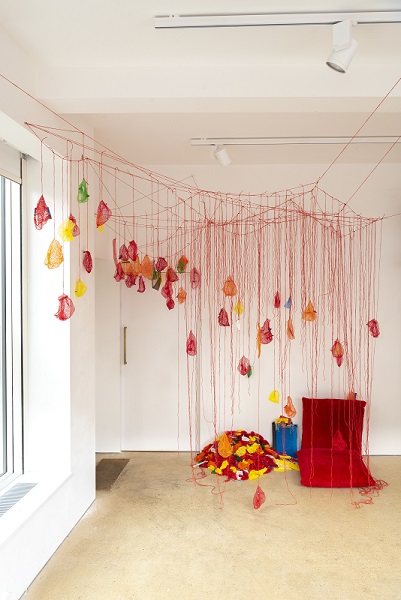
Tethering our thoughts at Incendiary, Day 1
Tethering our thoughts is a site-responsive installation made with red string. I loved making it. It was magical, like drawing in space or stitching the room! It was utterly absorbing. It’s my favourite kind of work; repetitive actions with plenty of intuitive decisions making it very meditative as well. I quickly entered that state of flow, where time flies. Bliss!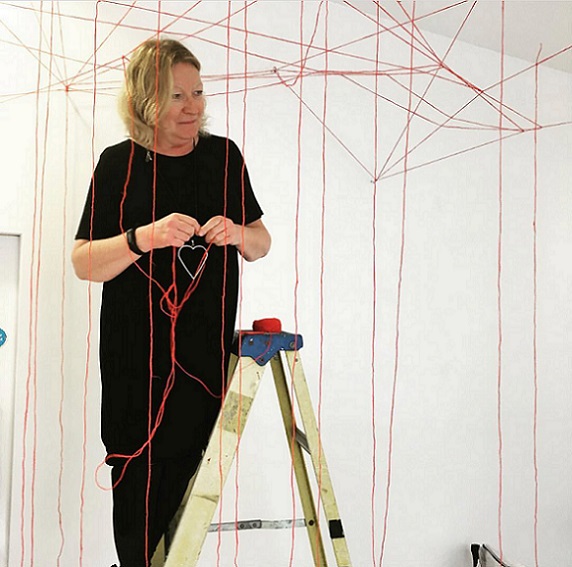
I especially enjoyed the unexpected ways that the string behaved. At times it looked as if the string were creating spontaneous drawings alongside my considered ones. The ends of string where I knotted the vertical strands created distinctive, self-supporting marks in space. I found it mesmerising. Next time I want to stitch a whole room!
Incendiary was a multi-site exhibition ‘responding to the firing of industrial incinerators and combustion fallout on human and more than human ecosystems.’ It was curated by Patricia Brien. For more details and images of the whole exhibition, see my Exhibitions page.
The focus of Incendiary at SVA was ‘Waste’.
As well as being a drawing in space, my installation, Tethering our thoughts, was interactive. The viewer was invited to become an active participant by adding fruit nets to the structure and by writing their thoughts about waste on a label and tying that to the installation too.
'Tethering our thoughts
an invitation to participate:
Please touch.
Walk into the space.
Sit, stay a while.
In the UK, we use about 20 times more plastic than we did 50 years ago
and only 1/3 of that plastic is recycled.
We send over 15 million tonnes of waste from our homes to landfill every year
and much of that ends up polluting landscapes, rivers and seas.
Write your reflections about
waste on a label.
Tie it to the installation.
Add some fruit nets to the structure.
Post photos on social media.
Come back and see how the space has been transformed.
Thank you for being part of #tetheringourthoughts #incendiaryexhibition #incendiary #waste @SVA__
@loubakerartist #loubakerartist'
I added cushions, clipboards, pens and labels so that visitors could sit and reflect inside the space, if they wanted to and left the installation to work its magic.
Why the title, Tethering our thoughts? Louise Bourgeois describes drawing as a way she tethered her thoughts. I consider this installation to be a form of drawing or mark making - with string, fruit nets and labels! I also wanted the installation to become a collective tethering of thoughts about waste, almost ritualistic, symbolic somehow of the power of the few to instigate change, a form of art activism.
And why fruit nets? Maybe slightly strangely, I’ve been collecting fruit nets for several years. They fascinate me. They retain a sculptural form even when they’re empty – a ghost-like trace of their former shape, a memory. For me, they become oddly alluring and strangely ethereal when they’re suspended. They are transformed. However, they are actually also a significant yet insidious part of the plastic problem. They’re ubiquitous and they cannot be recycled. I still find them weirdly compelling and I will reuse my collection in my work but I’m definitely going to stop buying fruit in them from now on!
On Day 2, I decided to remove the cushions, clipboards and labels. When I had proposed the installation, I had expected the space inside to be more distinct, a place to sit and reflect, but actually it wasn’t, possibly because it was so close to the door. I think that this decision changed the work quite significantly for the better. It became much more aesthetically pleasing and more sublime without the visual distractions of the functional elements. It was site responsive, so needed to be adaptable to whatever space it was in. The clipboards, labels and pens were still available nearby, however….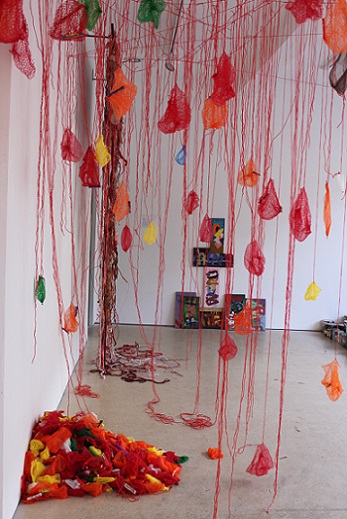
One unexpected delight is that being by the open door made the fruit nets and string move with every gust of wind. It was captivating! The string also created more spontaneous drawings which changed as the wind blew and as people interacted with the space.
On Day 2 I also added some more string, partly to make the installation more dense, but also because it was addictive. I wonder what it would be like to set up an installation like this as a durational performance? I’d love to do that…..
I added some labels with my own reflections about waste to the installation too. I saw them as provocations, a way to start the conversation…
I wasn’t in the gallery every day, but, when I was there, it felt like a great privilege to see the different ways people responded to the space and to talk with them about my work but also about issues surrounding waste. The reflections written on the labels also offer an alternative, poignant and accumulative response to the installation.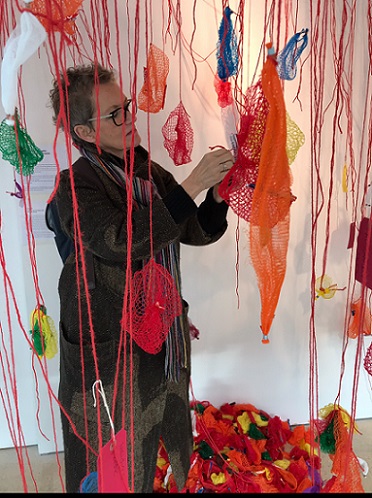
I really liked the fact that some people made their own sculptures with multiple nets and some wove or stitched the nets with the string.
I loved the way that each interaction was different and each changed the installation in some way. Each day was different and over the 5 days of the exhibition the installation was transformed. It became a collaborative piece. Each engagement influenced how the next person responded. It had momentum....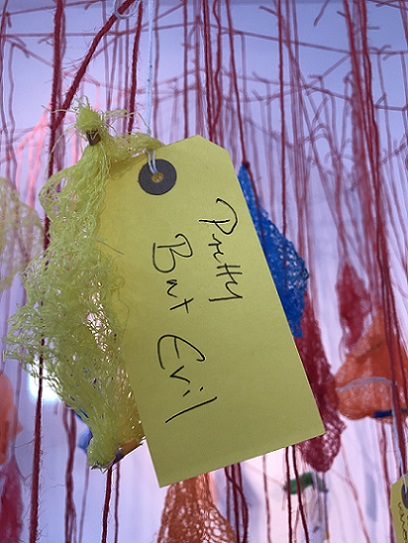
For more responses to the installation, more photos and my reflections please have a look at my documentation of Tethering our thoughts.
My dream is to set up a similar but much larger, walk-in participatory installation elsewhere and for it to be in situ for much longer. How would it change over time? I’d also like to be there all the time, to change the space myself, to engage with participants and also to document their responses and the ways in which the structure would change with time. Maybe I could use CCTV or time lapse photography as well?
Tethering our thoughts, Day 5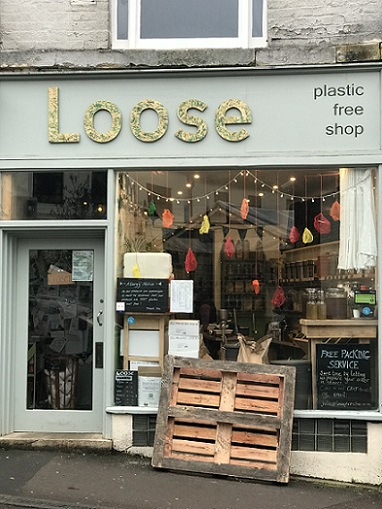
I also set up a tiny satellite installation in the local plastic free shop, Loose.....
As a result of Tethering our thoughts at Incendiary, I have a number of aspirations:
1. Reduce the single use plastic in my life, one area at a time
2. Set up a similar installation somewhere else for much longer
3. Stitch a whole room!
Many thanks to everyone who participated in Tethering our thoughts, to the curator of Incendiary, Patricia Brien, to SVA for hosting us and to all the other artists I met and worked with during the exhibition.
Watch this space!
2018 Living sculptures, a participatory installation at disquiet exhibition, Walcot Chapel, Bath, Sept. 18th -23rd
I was very pleased to have the opportunity to trial some of my Living sculptures for the week of disquiet exhibition at Walcot Chapel. I decided to just install the new, brightly coloured, hand knitted sculptures. There are 6 of them so far, knitted in vivid colours – green, turquoise, blue, orange and two pink ones. One of the pink ones is like some kind of head piece, so I hung the two together. 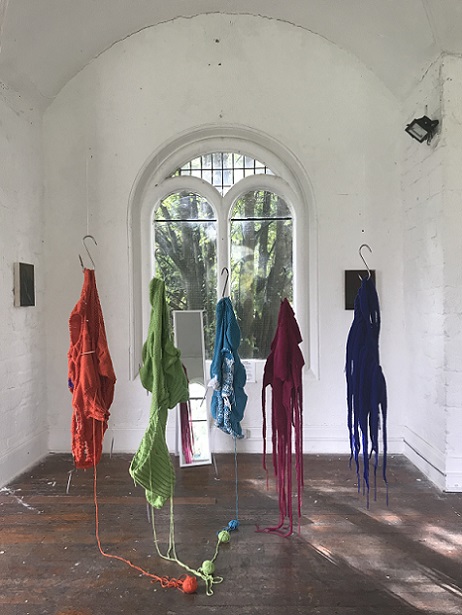
Each sculpture is potentially wearable. Some are garment-like, in that they have elements that are familiar as clothing –sleeves, cuffs and collars - but there the similarity to standard clothing ends! Some have more than two sleeves, some are not like clothing at all. They are abstract soft sculptures, and visitors are invited to wear them. Some of them still have knitting needles and balls of yarn attached. I could carry on knitting them or they could be unravelled….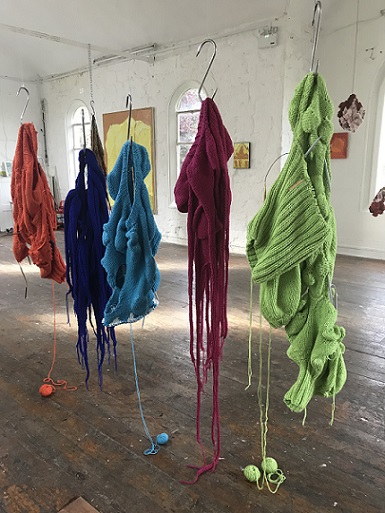
I hung the sculptures from 5 meat hooks so that the sculptures look as if they were suspended in mid- air. Some of them touched the floor, some of the balls of wool sat on the floor. I provided a mirror and an invitation to participate…..
I loved the ways that different people responded to the invitation and to the sculptures! Some people were embarrassed and didn’t want to engage, others quickly became absorbed. Please have a look at the full documentation of Living sculptures, including the research behind the concept, many images and my reflections. It also includes material from the Living sculptures day at Bristol Museum (see below) in July 2018.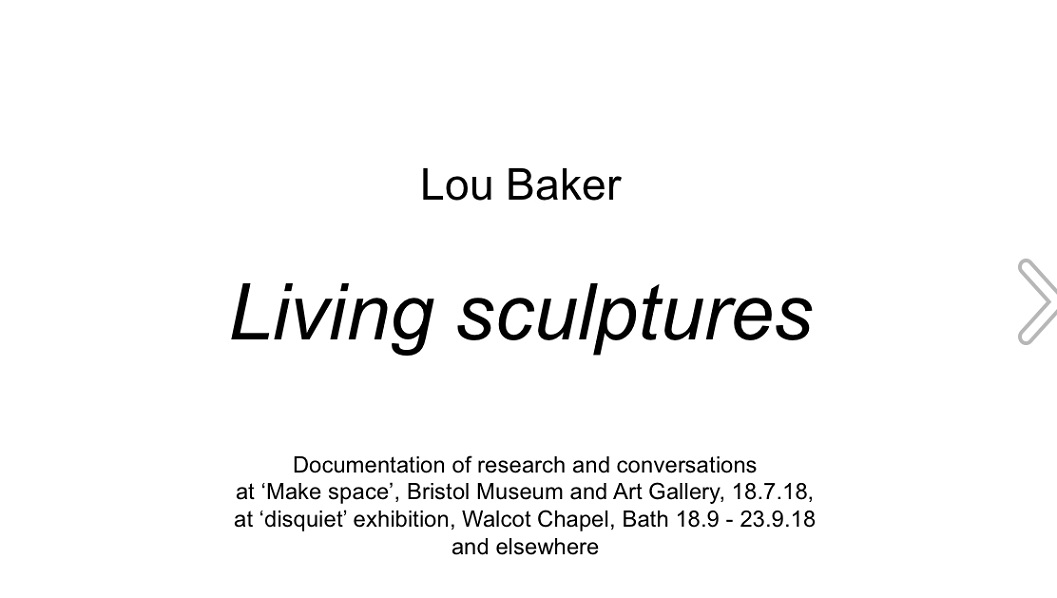
To view the documentation of Living sculptures, click on the image above.
Here are some fabulous videos of Living sculptures in action:
1. Living sculptures, knitted series
2. Living sculptures, trying them on
3. Living sculptures, green
4. Living sculptures, together
5. Living sculptures, twirling
6. Living sculptures, friends
7. Living sculptures, dancing
I have also written more about it on my Exhibitions page, and you'll find more photos there too. I've written more specifically about making the work on my Knitting page.
I feel privileged to have had the opportunity to talk to so many lovely people who willingly engaged with me and my work, allowing me to take photos and videos. Many thanks to all those who took part.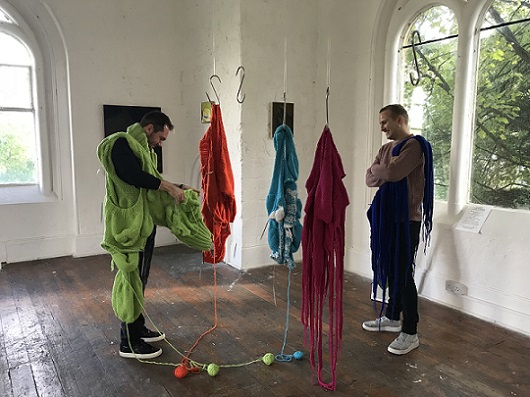
I feel that these pieces are interesting as more static sculptures as well as wearable ones. Hanging them on meat hooks, I think, adds a frisson of something unexpected. Apart from seeing visitors interacting with the pieces. I also really enjoyed the fact that each time they’d been worn and replaced on the hooks, they would take a different form. Sometimes they would be put on a different hook too, so it was an ever-changing installation in more ways than one.
I soon realised however, that using meat hooks in this way is potentially a risk. As soon as a sculpture is taken off a hook, it leaves a very sharp, moving point at face level! With just a few sculptures and being present throughout, I was able to make sure that no one hurt themselves, but for a more immersive installation, with more sculptures, I’ll need to find a different way of suspending the sculptures.
I am hoping to develop this idea further, to make different kinds of more readily wearable soft sculptures and to set them up as an immersive experience.
2018 Living sculptures at Make space, Bristol Museum and Art Gallery, 18th July
Living sculptures is an interactive, participatory installation of wearable, hand knitted and stitched soft sculptures. Normally, in an art gallery, there are signs saying ‘Do not touch’; what happens if the viewer is not only encouraged to touch but is invited to become a living sculpture by wearing an abstract soft sculpture? What would it look like? How would it feel?
I trialed the participatory aspects of this idea as part of a day at Bristol Museum’s Make Space alongside The Woman’s Hour Crafts’ Prize exhibition on 18th July 2018. I invited my visitors to become living sculptures by trying on a soft sculpture, or several!
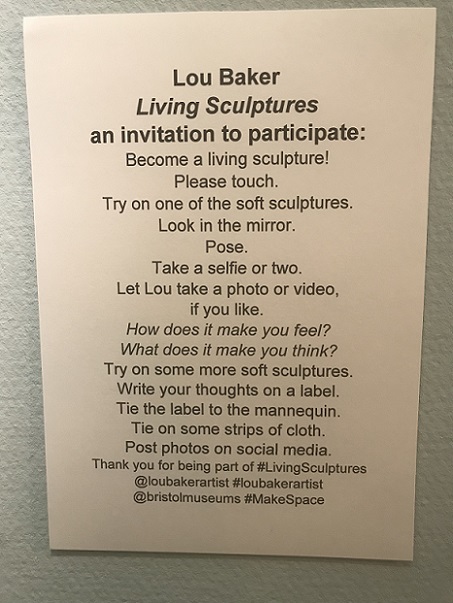
An invitation to participate!
I set up the Make space room, making the new, more wearable sculptures easy to access along with some of my original soft sculptures which can also be worn.
My first stitched, wearable soft sculpture, Living sculpture, furry.
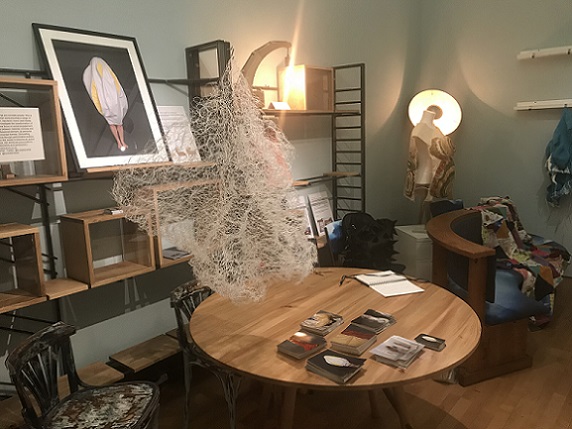
Part of the Make space, set up with a number of my soft sculptures, including the Living sculptures.
Have a look at this video walk through of the space at the beginning of the day. I rearranged it later in the day so that it looked like this.
I documented the event with photos, videos and interactive feedback. It was wonderful. I especially loved the conversations I had and the fabulous ways that people moved when they were wearing my work. It’s clear that the participants found it playful but also thought provoking. Many thanks to those who took part!
Here's a video of one of the participants wearing Living sculpture, furry. I love the way she starts rocking! This visitor started spinning as soon as she put on No animals have been harmed in the making of this garment, this lady began to dance and so did this one as soon as she put on Heart of darkness I!

One visitor exploring Living sculptures.
Identity is often communicated through the clothes we wear, but, at a deeper level, the multiple selves we reveal to the world can conceal our true sense of self. Living sculptures investigates this disconnect.
Another visitor wearing The whole is greater than the sum of the parts.
Most of my static soft sculptures are technically wearable, and at some point during the process of making, I try on all my sculptures. It’s part of making them me and is also part of my ongoing research into the links between clothing, body and identity. Yet they are, realistically, utterly unwearable. Have a look at the wonderful, quirky images of me wearing them, Wearing the unwearable.

Me, wearing Nobody 3.
Living sculptures is the beginning of a larger body of work in progress where, using traditional garment-making skills and unexpected materials, I am developing a selection of more readily wearable sculptures which can be put on and removed independently by visitors. I am merging my making with my social engagement! The passive viewer can choose to become an active participant, a performer; or, for the onlooker, the space will be transformed into a dynamic, ever-changing, interactive experience.
Carl Jung describes individuation as the process of finding meaning in life, and ultimately of finding our self. It involves balancing our multiple selves with the dark side, or shadow, of ourselves; failure to acknowledge and accept this shadow can result in fragmentation and associated mental health issues. Exploring this sense of being ‘other’, Living sculptures offers the viewer the opportunity to take on various temporary identities by trying on a selection of bizarre, handmade, wearable soft sculptures. 
My youngest visitor enjoying wearing No animals have been harmed in the making of this garment!
Encouraging participants to post selfies on social media provides valuable feedback, documentation of the experience and extends the project’s reach. This playful, interactive art adventure interrogates the boundaries between self and other, changes the balance of power in the gallery setting and questions the true value and authorship of art.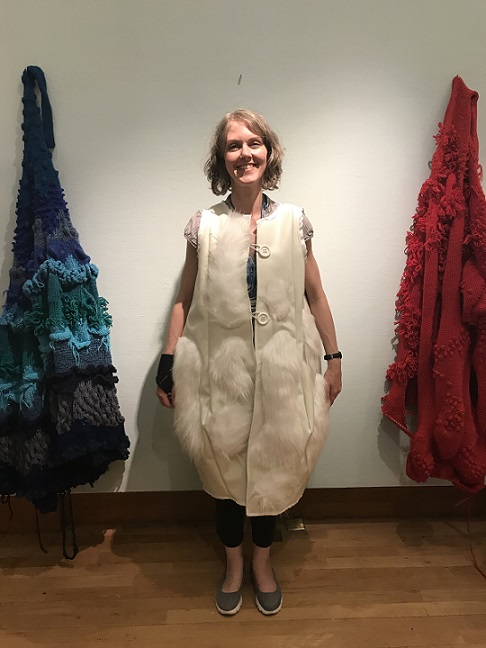
Have a look at a delightful video of this participant wearing Living sculpture, furry!
The sculptures also make an intriguing static exhibit. They have garment-like elements, but are clearly not functional clothes. They can be exhibited it any number of ways – on hooks, hangers, clothing rails, suspended from meat hooks, displayed on mannequins…. The list is endless. They could also be exhibited alongside photos of some of the wonderful participants who have worn them!

My new knitted series of Living sculptures.
The Living sculptures day at Make space was very valuable to me. Not only was it hugely enjoyable, but it was also very useful as research and I was able to gather some interesting feedback, both oral and written, about the experience. I’m now planning to add to this series and provide further opportunities for a larger, more immersive experience. I envisage a room full of my hanging soft sculptures, maybe like the installation at the PRILIC exhibition, amongst which the active participants, the Living sculptures can move. I’m looking forward to developing this idea further, maybe using CCTV to record and play back the visitors’ interactions with the sculptures.
Update, October 2018: Have a look at the research and documentation of the Living sculptures project so far, including a week at 'disquiet' exhibition at Walcot Chapel, Bath in Sept 2018.
A room full of my hanging soft sculptures at PRILIC, Jacob's Wells Baths, Bristol, Dec 2017
For more about the works in progress, have a look at my knitted Living sculpture, pink, blue, orange, turquoise and green and my new stitched Living sculpture, furry.
Here are more photos of the Make space and more of the wonderful images of the Living sculptures being worn:
1. Make space at Bristol Museum and Art Gallery
2. Living sculptures: an invitation to participate
3. My first stitched wearable soft sculpture - Living sculpture, furry
4. A series of knitted Living sculptures, displayed in the space
5-10. Views of Living sculptures at Make space
11-26. Some of the wonderful participants wearing the Living sculptures and some of my other soft sculptures
2017
Safety net at Synecdoche's [dis]place residency at The Vestibules, Sept
Safety net at [dis]place is the 3rd iteration of the Safety net idea. The first was part of Refuge: in search of safety at Fringe Arts Bath in May 2017, the second at St. Werburgh’s Primary School in June. At the school it had a different focus as it was part of an Aspiration Day for Year 5s and 6s. There I called it My future. Scroll down the page for more information about both of these installations.
Each time I have set up Safety net it has been very different. At Fringe Arts Bath I was given half a room in a semi derelict shop and I was able to staple the netting to the walls, ceiling and floor. I think this has been the most satisfying set up so far as it felt as if I was sculpting with netting and a stapler and was very intuitive. It was utterly site responsive and has been the most aesthetically pleasing installation so far.
Safety net, Day 1, at Refuge: in search of safety, Fringe Arts Bath, May 2017
At the Primary School the set up was, possibly inevitably, much more limited in that I was asked to set it up over some climbing equipment. It obviously made it into a very different space, but was adequate for the setting and the students responded with curiosity and thoughtfulness. The Safety net concept ticks lots of boxes in terms of accessibility; it’s a provocation, it’s kinaesthetic, and it's differentiated, it will suit different types of learners.
My future at St Werburgh's Primary School, Bristol, Aspiration morning, 6th July 2017
For Safety net at The Vestibules, I knew I wouldn’t be able to use staples as it’s a listed building so I planned to create the netting structure by tying it to a couple of tall garment rails. I found this was much less aesthetically pleasing than the installation at Refuge, but in the circumstances it worked. Each Vestibule was quite an awkward space to use, in some ways, as we had to keep clear gangways from each inner doorway as they were fire exits. We also had to negotiate space between 7 artists.
Safety net, Day 1,5.9.17 at [dis]place at The Vestibules, Bristol, September 2017
My little safety net was dwarfed by the size of The Vestibule though! I would be thrilled to set it up again in that space. Next time I’d see if it could be more sculptural and site responsive and I’d attach it to the infrastructure of the building. I would probably need very tall ladders, or a scaffolding tower, maybe a couple of technicians and definitely the whole space!
The garment rails have wheels and I had planned to wheel the structure outside onto the open public space outside The Vestibules, College Green, on dry days to see what would happen. Needless to say, once the structure was set up, I realised how hard it would be to move it, especially alone, so it didn’t happen. I also became engrossed in my displacement activities and was busy doing other things most of the time.
It’s interesting to compare Safety net at [dis]place with Safety net at Refuge. At [dis]place it was in place for 20 days, at Refuge it was up for 17 days. At Refuge the changes from Day 1 to the end are much more evident. The written responses are similar in both settings, although there were fewer labels and fewer pieces of cloth attached at The Vestibules. I think there are a number of reasons for this. At Refuge, the footfall was much higher, Safety net was the only participatory piece in the exhibition and I also spent some time adding pieces of cloth to the net when I was there as a kind of performance. At Refuge, Safety net was a more private space for reflection because of the way the exhibition was set up. Also the focus of the whole Refuge exhibition was on safety and, as many of the pieces of work on show dealt with troubling issues, it seems to me that some viewers used the labels to reflect on the whole show, not just on Safety net. At [dis]place, on the other hand, we had fewer visitors, there were several other interactive pieces and I decided not to add pieces of cloth this time. Although the focus of the residency at The Vestibules was [dis]place, the ways that the artists interpreted that term were very varied. I also wonder if the set up and aesthetics of the piece at The Vestibules made it less appealing.
One happy participant!
The responses to Safety net at [dis]place were still very positive, nonetheless. I have kept all the labels and at some point I’ll document them, but in the meantime have a look at the record I made of the residency, Displacement activity. It includes some reactions to Safety net as well as the documentation of my other displacement activities. I have also included photos of a number of the labels in the gallery below.
One of the labels tied on to Safety net at [dis]place
Leaving Safety net to do its thing is another example of change in control. I found at Refuge that if I talked to people about their responses to the net they became inhibited, but if I left them to it they would spend more time inside the net and more time reflecting. I hope it’s a non-threatening way to enable the viewer to find their voice, which can be anonymous or not. Sometimes, however, people didn’t want to write, but talked to me instead, so I have scribed some of the labels. This was particularly true of a group of adults with learning difficulties. I was delighted too that the wheeled rails meant that we could expand the entrance and the space so that one of them, a wheelchair user, was able to go inside!
Inviting the viewer to write a label is also a very useful, and hopefully not too intimidating, way to get feedback on the work. Feedback by stealth?
Safety net, a private space for reflection?
Another change in control is how the structure changes with each interaction. Apart from setting it up, tidying the space from time to time, taking photos and occasionally talking to people about it, I did nothing and yet with each added piece of cloth or label the space changed. It’s hard to categorise this piece of work and it raises a number of possibly unanswerable questions. It’s obviously an installation, it's site responsive, it’s participatory and interactive but should it also be called a collaboration? Is it social engagement? I see myself as the facilitator, but the idea is mine, so I am also the artist. But are the participants artists too? Co authors?
Friends who work in Early Years education call this a provocation; apparently that’s a thing with pre-schoolers. I think it’s a fitting term for my work as well.
Safety net at [dis]place, Day 18, 28.9.17
An unexpectedly poignant aspect to Safety net has been the deconstruction of the net each time. Taking it down the first time, after Refuge, I only had time to bundle the nets into a bag, with the labels and cloth strips attached, and bring it home. Have a look at a video of me bundling the nets into a bag. On reflection it became clear that it’s temporal and site-dependent too, a transient piece, so it no longer has an identity when it’s no longer in situ. I think this makes it especially poignant; it is the setting and accumulation of interactions that make it what it becomes. As a time- and site-responsive piece, inevitably the documentation is critical. Keeping the piece intact defeated the object, it needs to be a blank canvas in each new setting and so I began to unravel the cloth and untie the labels….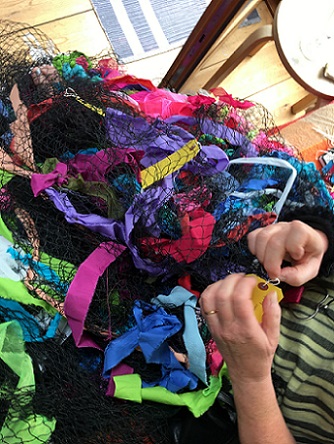
Beginning the long, slow process of unravelling Safety net
Making work can be cathartic and satisfying and ‘un making’ can be similarly therapeutic. This work was repetitive, time-consuming and oddly reflective as each time I did it with a group of friends and we read the labels to one another as we untied them. It felt strange though to be undoing the effort of others, but also like part of the circle of life. It makes me think of the myth of Penelope who wove by day and unravelled by night....
And what is left each time? 2 unadorned pieces of garden netting, with traces of coloured threads still attached, three bin liners of strips of coloured cloth and a pile of responses on labels. It seems appropriate that most of it can be recycled and significant that a safety net is so transient….
However it is defined, Safety net does seem to be an effective way to enable people to reflect and respond to a particular subject. I’m looking forward to having opportunities to set it up again in different spaces and contexts, maybe with a different title and focus.
Gallery of images of Safety net at [dis]place:
1-7. Day 1, 5.9.17: Sculpting with netting, elastic and two garment rails!
8. Day 1, 5.9.17: Safety net at [dis]place
9. Day 2, 6.9.17
10-12. Day 3, 7.9.17
13-27. Day 4, 8.9.17
28. Day 6, 12.9.17: How small Safety net seems!
29, 30. Day 8, 14.9.17
31-33. Day 9, 15.9.17
34-39. Day 10, 18.9.17
40. Day 12, 20.9.17
41. Day 13, 21.9.17
42, 43. Day 16, 26.9.17
44. Day 17, 27.9.17
45, 46. Day 18, 28.9.17
47, 48. Day 19, 29.9.17 This little boy spent some time inside Safety net with his mum and did some drawings. He wanted to take this yellow label home with him so he could remember the experience!
2017
My future at St Werburgh's Primary School, Bristol, Aspiration morning, 6th July
I was asked to take part in an Aspiration morning for Year 6 students of 5 local primary schools. It was about inspiring the children so that they could find out about different careers. I was there to tell them what it’s like to be an artist. I thought it would be fun (for them and for me!) to set up a version of Safety net, but with a different focus so that the students could be actively involved. I decided to call it My future and invited the students to think about their future and write down one thing they were excited about and one thing that worried them.
My future at St Werburgh's Primary School Aspiration morning
This time I used the moveable climbing frames to make the structure, draping the netting over them to make it den-like. It meant that there were in fact two spaces, which worked well as, at times, there were lots of children who wanted to join in. I don’t think it was as aesthetically pleasing as Safety net at Refuge, (see below), but it worked well in this context.
The students seemed to really enjoy writing or drawing their thoughts on the labels and then attaching them to the netting with the strips of coloured cloth. It was very lovely to see them being engaged - thinking, talking and having fun! I was very grateful to Alice Smith for coming to help. She was especially good at getting the children to talk to her.
'I'm excited about secondary school.'
I still have to document their responses, but predictably, the most common thing the students were excited about was also the thing that worried them – starting secondary school. There were some wonderfully aspirational labels as well!
Here is a video of My Future.
And here is a gallery of images:
2017
Safetynet at Refuge: in search of safety, Fringe Arts Bath, May 26th - June 12th 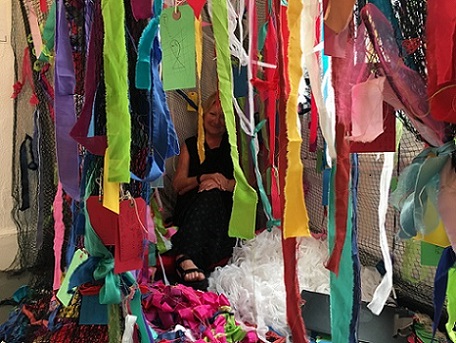
Lou Baker inside Safety net at Refuge, Fringe Arts Bath, Day 17, 12th June 2017
Safety net is a site responsive, temporal installation made with garden netting. At Fringe Arts Bath, I was able to create the piece by stapling it to the walls, ceiling and floor. It definitely felt like drawing or sculpting with netting! The viewer is invited to go in to the den-like space and reflect on safety, and then respond to it by adding strips of brightly coloured, torn cloth to the structure and also writing their thoughts an a label and attaching it as well.
Safety net at Refuge: in search of safety, Fringe Arts Bath, Day 1, May 26th 2017
It was thrilling to see how the installation was transformed from a public place to a more private space over 17 days and how the actions of the participants changed not only the look of Safety net, but the form too. It was thought provoking to read the reflections of the participants - some frivolous, some funny and some very poignant. Have a look at the documentation of Safety net's development over 17 days at 'Refuge; in Search of Safety.'
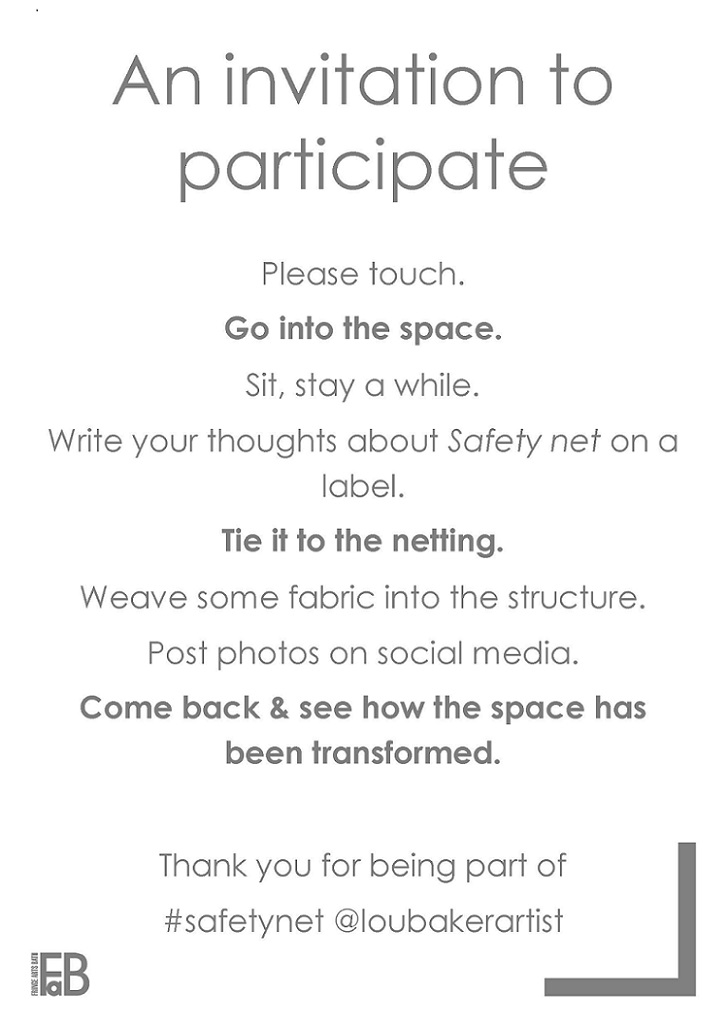
An invitation to participate....
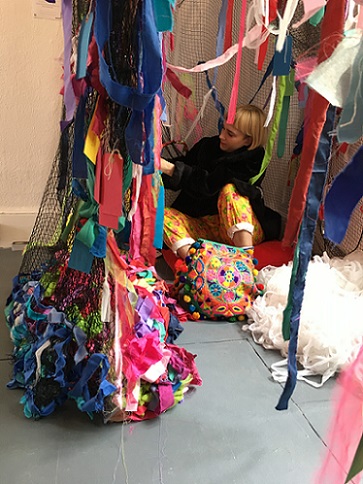
Safety net, Day 12

One visitor came back, bringing her sister, Day 14
Initially, this net structure provides no privacy, no shelter, it’s just a minimal, see-through barrier to the inside. As time passes and the work develops, the accumulation of responses will obscure the inside of the structure and make it a much more satisfactory hiding place or shelter; or will it? As it changes, how will that change the reaction of the viewer? As passive viewer becomes active participant, how will their interaction change the space for others? Inhabiting it, being still there, sharing the space, interacting with the structure; for each person it will be a different experience.

Safety net, Day 15
A seemingly superficial participatory interaction becomes a provocation which explores the liminal space between safety and danger. Where some feel safe, others will feel claustrophobic, where some feel calm, others will feel uncomfortable. It will question our security and make public things that are normally private. It will also give the viewer a glimpse into the experiences of the many people who are forced to live in a world of transient shelters. It will highlight the vulnerabilities and insecurities of an ephemeral resting place.
Is it a trap or a den?'
2016
Don't wash your dirty laundry in public, during Synecdoche's Bodies residency at The Unit, Bristol,
Don’t wash your dirty laundry in public is part of the art work I produced at Bodies: a group residency by Synecdoche. It’s based around a series of temporary installations of used clothing which took place between 1st and 30th September 2016 in an empty shop in a busy shopping area in the centre of Bristol, UK. The space was open to the public for 4 days a week. It took on a life of its own and became part social engagement, part performance but was also participatory, confessional, interactive, and highly conceptual.
Clothing is often thought of as a second skin; it makes us think of bodies. It’s quite unusual to use it in art. It’s soft and impermanent and can remind us of our mortality. It also somehow mixes up the senses of touch and sight. There are strong links with memory too. Clothes, when worn, take on the shape of the wearer and become sculptural. When they are empty, they can suggest absence. Hanging them increases this sense of loss. When the clothing is second hand, other elements come into play, including abjection and contamination anxiety.
I have, essentially, spent a month hanging out the same clothes again and again in different ways in an empty shop, arranging them in body bags, talking to people, writing down their comments and taking photos. The clothes belong to my family and I’ve been giving them away. It has made me feel very vulnerable at times. I have been making public things that are normally private. I am delighted that it has provoked a range of conflicting responses - attraction, repulsion, horror, hilarity, grief, comfort, understanding and incomprehension, amongst others.
Have a look at thepresentation I made at the end of the residency, Don't wash your dirty laundry in public, which documents some of the comments, conversations, photos and reflections on my series of temporary installations of used clothing at The Unit Bristol. Thanks again to everyone who so generously shared their thoughts with me and allowed me to write down their comments and take photographs!
I've also written a blog post with some of my thoughts about the experience. And here is a video of me talking about my work.
#whatdoartistsdoallday
#everydayisdifferent
Gallery of images of Don't wash your dirty laundry in public:
1. Don’t wash your dirty laundry in public, used clothing, shoes, pegs, washing line, hand written title
2. Second hand clothes, mind map accompanying the installations
3. Day 4, 4.9.16 Don’t wash your dirty laundry in public; it begins! Some clothes hung from meat hooks; a pile of clothes and shoes, the FREE CLOTHES sign
4. Day 4, 4.9.16 Don’t wash your dirty laundry in public, members of the public looking at the free clothe
5. Day 4, 4.9.16, one corner with clothes pegged on the washing line
6. Day 6, 6.9.16, with some clothes hanging from hangers at the front
7. Day 6, 6.9.16, two members of the public trying on clothes
8. Day 8, 8.9.16, sagging lines!
9. Day 8, 8.9.16, trying on a t-shirt in front of the mirror
10. Day 9, 9.9.16, unpegging
11. Day 9, 9.9.16, more unpegging
12. Day 9, 9.9.16, a different performance installation
13. Day 11, 11.9.16
14. Day 11, 11.9.16
15. Day 15, 15.9.16, reflection
16. Day 15, 15.9.16
17. Day 15, 15.9.16, rearranging
18. Day 15, 15.9.16, another performance installation, clothes in body bags, still free
19. Day 15, 15.9.16, detail of clothes in body bags in front of the chalk wall
20. Day 16, 16.9.16, members of the public rummaging through a pile of body bags to look at clothing
21. Day 16, 16.9.16, shoes
22. Day 16, 16.9.16
23. Day 16, 16.9.16
24. Day 16, 16.9.16
25. Day 16, 16.9.16, trying on a shirt
26. Day 16, 16.9.16
27. Day 16, 16.9.16, being zipped in to a body bag
28. Day 17, 17.9.16
29. Day 17, 17.9.16
30. Day 18, 18.9.16, a member of the public getting into a body bag
31. Day 21, 21.9.16, tidy shoes, FREE SHOES
32. Day 22, 22.9.16
33. Day 22, 22.9.16
34. Day 23, 23.9.16,another of the many performance installations
35. Day 23, 23.9.16, some of the artists trying on clothes
36. Day 23, 23.9.16
37. Day 25, 25.9.16, BODY PART-y, Don’t wash your dirty laundry in public, final installation
38. Day 25, still from the video of me talking about my work
2016
Tethering our thoughts: a collaboration between Lou Baker, Gina Baum, Helen Acklam, Laura Waite, Maura Zukina, Nicola Pearce, Alice Jennings, at 'Bodies: a group residency by Synecdoche', 24th - 29th September 2016.
In September 2016, 12 members of Synecdoche took over an empty shop in the centre of a busy shopping area in Bristol, UK for a month. It was open to the public for 4 days a week. We set up studio spaces, made work in the space, held workshops and interacted with the public. We called it 'Bodies: a group residency by Synecdoche'.
For most of the month the focus of my work was on Don’t wash your dirty laundry in public, a series of changing installations of my family’s used clothing which I hung out in the space and then gave away. I invited the viewer to try on the clothing and take it away. I also encouraged them to tell me what they thought about the experience, wrote down some of the comments and conversations and took lots of photos. I have documented it here.
Tethering our thoughts, 24th September 2016
Alongside this, I was interested in using the space for a collaboration. I had an idea that some of the artists could work together to make a large scale, participatory, walk in, textile installation. Others were keen, so we planned it, but in fact found that we were so busy with other things that we ended up installing it on Day 24, the day before the closing party.
Its form was site responsive and intuitive. We used garden netting, hooked and stapled to walls and ceiling, for the structure and had cushions inside. We provided a selection of materials to tie and weave into the netting, and a clip board with the question: ‘Trap or den?’ We then started adding to it and encouraged our visitors to join in.
We called the piece Tethering our thoughts as that was what I was reminded of as we set up the tent-like structure; Louise Bourgeois describes drawing as a way to tether her thoughts and we saw this participatory installation as a form of three dimensional drawing.
The response was delightful. Some people came and just sat inside the space on the cushions, some alone and others in groups. Others became absorbed, weaving pieces of fabric, yarn and pipe cleaners into the netting. 
More participants!
1. Materials
2. Planning
3. - 5. Setting up
6. - 12. Participation
13. - 19. Details of the installation
2015
Do you mind if I write that down? My accidental introduction to social engagement, Oct and Nov
In 2015, as Embroiderers’ Guild Scholar, I was invited to exhibit my work as part of The Embroiderers’ Guild Graduate Showcase for 5 days at The Knitting and Stitching Show in London in October and 4 days in Harrogate in November.
Lou talking to a visitor about her soft sculptures
at The Knitting and Stitching Show, London, October 2015
I was, frankly, rather nervous about exhibiting in this context as I imagined that most visitors would want to see beautiful, colourful, benign textile art.
As the show opened I wanted just to sit and become absorbed in my knitting but I quickly realised that if I didn’t actively engage with the public, I’d miss an unprecedented opportunity to get valuable feedback; in a gallery setting the artist might usually only be present for a couple of hours during a private view or when invigilating. In this setting I was with my work from 10-5 for 9 days over the 2 shows.
Because it was so busy and I felt it was very important for me to record the responses of my public, I began to ask people, as we were talking, whether I could write down their comments. And so it began; it hadn’t been planned, but it became something invaluable to me – documentation of the event and the fabulous range of responses to my work mixed in with my reflections of our conversations. 
Just a few of the wonderful responses to my work!
For more, have a look at the full documentation, 'Do you mind if I write that down?'
There was definitely an element of performance in it. My interest in each person’s thoughts and opinions was entirely genuine, and I also made myself vulnerable and discussed private things, but over the course of time, it became performative as I reached for my sketchbook and pen and asked ‘Oh! Would it be OK if I write that down?’ For more about the performative aspects have a look at my Performance page.
In conversation at The Knitting and Stitching Show, London
*Please scroll down for more images and information about installations and site responsive works*
My installation and site responsive work
Many of my knitted and stitched sculptures are installed or hung. Most of them, especially the knitted pieces, rely on tension and/or gravity for their form. It is thrilling working with soft materials like cloth and knitted fabric as it’s so flexible, in every sense of the word.
As well as these soft sculptures, increasingly, over the past few years I've started making larger scale site responsive installations. So far I've used garden netting, string and monofilament and have ideas for plenty of other materials as well! Most of them are participatory too. Scroll down to find out more about these transformed spaces.....
Tethering our thoughts at Incendiary, SVA, Stroud, Feb 2019
Shroud, 2013, installed at Unravelling, October 2016
That cloth is an unconventional medium in fine art also adds to the meaning it conveys. Traditionally, hard, durable materials like stone, marble and bronze have been used for sculpture; the soft, impermanent nature of cloth, however, evokes the human form and its mortality, revealing alternative meanings in its folds and surfaces (Barnett 1999: 186) and seems to ‘take on a bodily resonance rather than to offer up symbols as such’ (Nixon 2005: 174). 
All the babies I might have had I, felted hand knitting, 2010, installed in an empty shop at Pattern, Fringe Arts Bath, 2016. As I installed it I felt as if I was stitching it to the room!
Choosing to hang soft sculptures evokes an abject response and can be very powerful. An ‘empty’ hanging form suggests loss, absence and death. Hanging a sculpture also emphasises it’s ‘fragility and vulnerability’ (Larratt-Smith 2011). Louise Bourgeois asserts that the hanging thing ‘…is very helpless’ (in Nixon 2005:170) and ‘Hanging and floating are states of ambivalence and doubt’ (in Larratt- Smith 2011). It is clearly significant to her. I think the hanging motif distinguishes ‘very different identities for ... sculpture ... suggesting a kind of displacement’ (Barlow 1996: 9) which also adds to the feeling of abjection.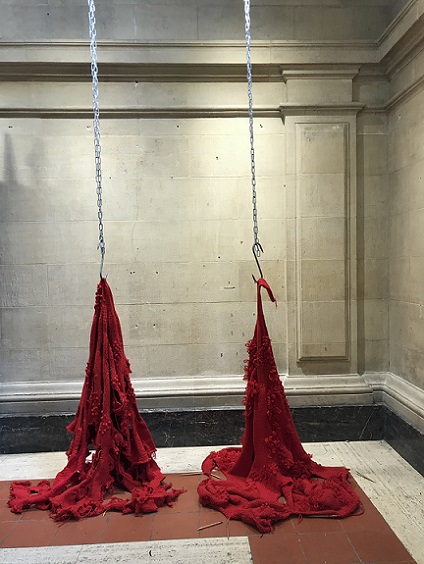
My Heart of darkness hand knitted diptych is especially versatile. Here are just 2 of the ways I've installed it. For more installations, see my Knitting page. Both of these were at [dis]place at The Vestibules, September 2017
Have a look at my Knitting and Stitch pages for more examples of how I have installed all my soft sculptures.
Many of my soft sculptures are also site responsive. I’m always particularly keen to install my work in unexpected places; it’s exciting to see how some pieces of work can have so many iterations. Have a look at the following exhibitions especially: Privy, Bodies at The Unit, Unravelling, Prilic, [dis]place, Window wanderland at 212 and several venues at Fringe Arts Bath in 2016 and 2017. Have a look at these pieces of work: Safety net, Shroud, Heart of darkness, All the babies I might have had I, Nobody 3.
And do have a look at my blog post Art in unexpected places? for more thoughts on this.
Nobody 3 installed at Unravelling, October 2016
Nobodies and The others are installations too!
Nobodies, 2014, installed at Synecdoche, Embassy Tea Gallery, London, July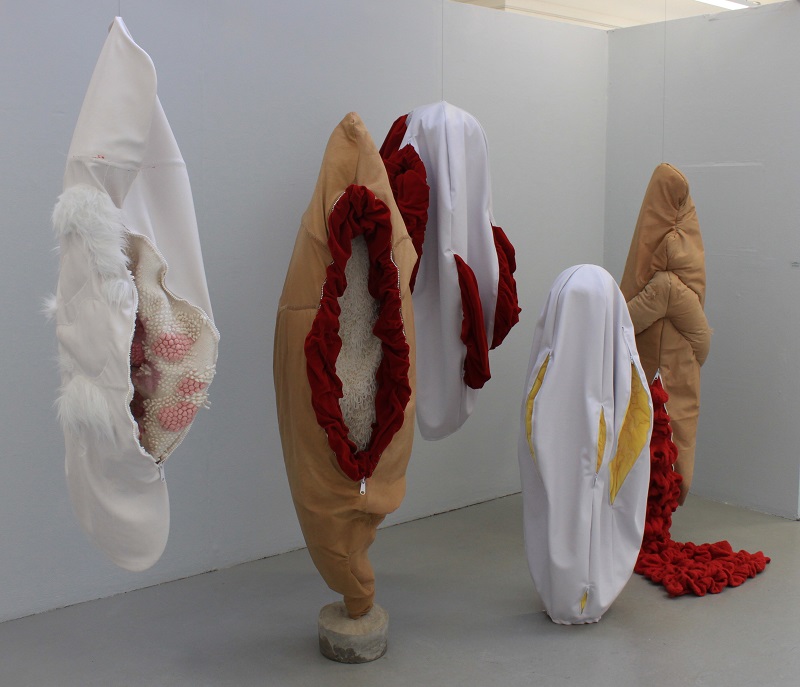
The others; a self portrait, installed at The Degree Show, UWE, Bower Ashton campus, Bristol, July 2015
I’m not really sure that all the parts of Displacement activity should be on this page either; Displacement activity #9: Sculpting with pill packets and a stapler could also be on the Stitch page, I think, and I’m not sure where Displacement activity #11: Collaborative drawing fits at all!
Nobody 3, 2014, hand knitted wool, meat hook, installed temporarily in the toilets at City Hall, during Synecdoche's [dis]place residency at The Vestibules, Bristol, September 2017
References:
Barlow, Phyllida, ‘The Sneeze of Louise’ in Cole, Ian, (ed.), 1996, Museum of Modern Art Papers, Volume 1 Louise Bourgeois, Oxford: Museum of Modern Art pp4-11
Barnett, Pennina, 1999, ‘Folds, fragments and surfaces: towards a poetics of cloth’ in Hemmings, Jessica (ed.), 2012, The Textile Reader, Berg: London, New York pp 182 -190
Larratt-Smith, Philip, 2011, Louise Bourgeois, the theory and practice of psychoanalysis, Available from: http://arttattler.com/archivebourgeois.html [Accessed 6 November 2013]
Nixon, Mignon, 2005, Fantastic Reality: Louise Bourgeois and a story of Modern Art, Cambridge, Massachusetts and London: MIT Press
2019 Red is the colour of.... at B-Wing, Shepton Mallet Prison, 21.9-6.10.2019
2019 IN.BRS.2019.39, Shadow sacks over dark pool, a collaboration with Scott Sandford at B-Wing, Shepton Mallet Prison 21.9-6.10.2019
2019 Shadow sacks (Slopping out room) at B-Wing, Shepton Mallet Prison, 21.9-6.10.2019
2019 The presence of absence, at B-Wing, Shepton Mallet Prison 21.9-6.10.2019
2019 Tethering our thoughts at Incendiary, SVA, Stroud, 6th -10th Feb

Tethering our thoughts is a site-responsive installation made with red string, with added fruit nets and labels! I loved making it. It was magical, like drawing in space or stitching the room! It was utterly absorbing. It’s my favourite kind of work; repetitive actions with plenty of intuitive decisions making it very meditative as well. I quickly entered that state of flow, where time flies. Bliss! 
I especially enjoyed the unexpected ways that the string behaved. At times it looked as if the string were creating spontaneous drawings alongside my considered ones. The ends of string where I knotted the vertical strands created distinctive, self-supporting marks in space. I found it mesmerising. Next time I want to stitch a whole room!

Click on the image below to see my full documentation of Tethering our thoughts including the ideas behind the piece, set up, responses, my reflections and lots more images. This installation is also participatory, so there are more details on my Participatory art and social engagement page. 
2018 Unseen, drawing in space with red monofilament at disquiet exhibition, Walcot Chapel, Bath, Sept 21st -23rd
Over 3 days during the disquiet exhibition at Walcot Chapel in Bath I made a site responsive installation outside the chapel in the porch using red monofilament. I loved making it. It was like drawing in space.
Have a look at a slideshow of images by clicking the image below:
Also, here's a video of my drawing in space at Walcot Chapel.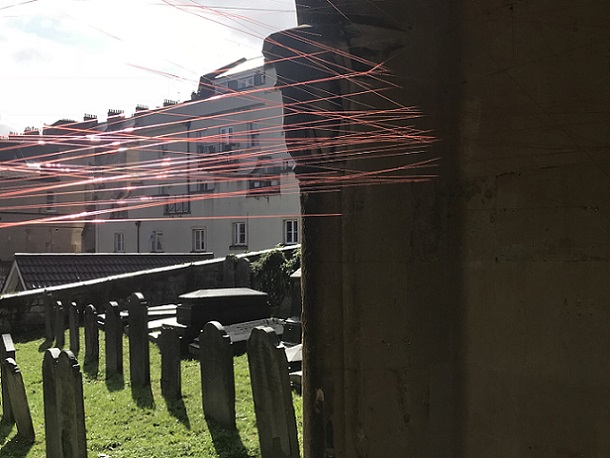
The chapel is a listed building so I couldn't make new holes which meant that I had to use the holes that were there, so there were limits to what I could do. I really enjoyed seeing what was possible within these parameters. I started by using any screws or nails that were already there, but I noticed that there were lots of holes with rawl plugs in them so on the second day I added some screw hooks. That gave me plenty more fixings and much more freedom!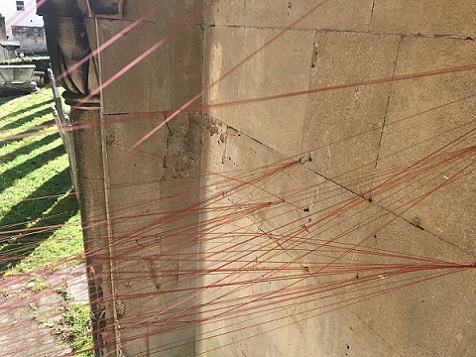
I really enjoyed the way that the monofilament changed with the light, and as it was installed. It’s obviously plastic, strong and weather resistant. Its normal function is fishing line. I like the idea of using something prosaic and manipulating it so that it becomes something unexpected. The installation was a transformation.
The form was basic; intersecting lines filling a space to one side of the chapel door, looking out over the graveyard. It interested me how the aesthetics changed as I added more to the piece. I noticed that the lines began to interfere with one another, some like an optical illusion and some physically, actually distorting the lines that had gone before. I felt it became something else, sparkling, web like, magical, yet almost invisible.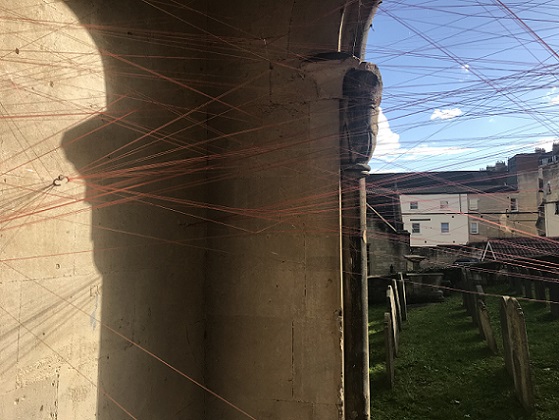
Although there was rarely anyone else present, it felt like a form of performance. It was blissful; I had to make intuitive decisions, it was repetitive and meditative. I quickly entered the state of flow where time flies.
One down side of its invisibility was that it was rather a hazard! Several people accidentally walked into it as they made to walk through the arch. Consequently, I added a sculptural piece of knitted monofilament, including knitting needles, to the installation to make it more visible. 
Knitting with monofilament is an uneasy change in control, as the unruly plastic line has a life of its own. Knitted monofilament looks rather like a magnificent scribble. Paradoxically, though, it needs a different, more intense kind of concentration, and more control than knitting with wool. I think adding this small knitted piece made an interesting contrast to the straight lines, and the seeming order, of the main part of the installation.
I’m intrigued by the ephemeral nature of an installation like this. I started making it on the 21st September and took it down on the 23rd. It was in situ just for 3 days, changing whenever I had time to work on it. It was seen by very few people, partly because of the setting, the weather and the fact that it was practically invisible! If I hadn’t documented it, no one else would have seen it, so, in some ways, the documentation becomes an extension of the art work. Now, thanks to the internet, potentially everyone could see it. It changes its reach and possibly its value. This extends to the performative aspects of its making as well; if nobody sees the performance and it’s not recorded, is it a performance? This all raises a number of questions for me and my practice. I know they’re not unique to me, but I want to investigate this transience further. 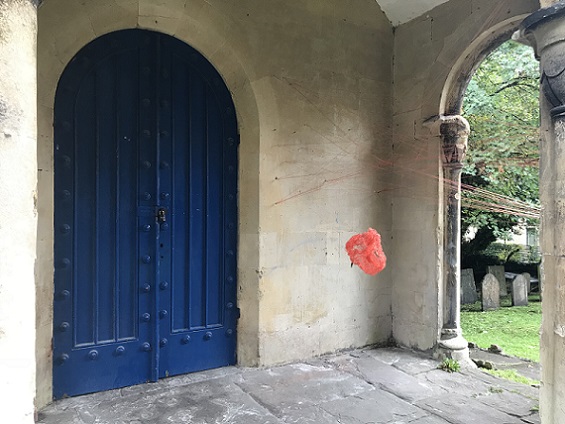
I'd like to do something similar in a much larger space, either outside or inside, and possibly both! It could be interesting to make an installation with monofilament amongst a copse of trees, or in an enclosed space. I’m currently looking for an opportunity to do both of these!
2017 Multitude at PRILIC exhibition, Jacobs Wells Baths, Bristol, December 8th-16th
Multitude is an installation of 11 of my life-sized stitched soft sculptures. Nine of them are suspended by meat hooks and chains from scaffolding 10 meters high, two of them are free standing. It’s the first time I have been able to install all of these sculptures together and it’s a dream come true!
Multitude is made up of a couple of series of sculptures (Nobodies and The others; a self-portrait) a knitted diptych (Heart of darkness) and a single sculpture (All the babies I might have had II). They have been exhibited in various combinations over the past couple of years and in a number of settings and have received a wonderful range of responses – attraction, repulsion, horror and hilarity amongst other things. I have documented a range of responses to them here.
Since I made the second series, The others, my vision has been to have a roomful of soft sculptures hanging close to one another so that walking through them becomes an immersive experience. Multitude is the closest I’ve come to this vision and it fills me with delight.
Jacobs Wells Baths was originally a Victorian swimming pool but has been a dance centre for the past 30 years and for the last couple of years it’s been a Community Arts centre. Several distinctive architectural features still reveal this astonishing building’s history; the tiled edge of the pool is still clearly visible, as are the remains of the rather primitive shower cubicles. The roof is arched with Victorian sky lights. The pool has been covered with a sprung wooden dance floor and at the far end of the cavernous space is a large dance mirror. Its semi derelict, dilapidated state is the perfect setting for my work.
I have been interested in the idea of art in unexpected places for a while and have shown my work in a number of unusual settings over the past few years – The Edwardian Toilets, The Vestibules, at several venues as part of Fringe Arts Bath in 2016 and 2017, at Unravelling, at Bodies in The Arcade and in the window of Room 212. I feel that my work becomes something ‘other’ in a non-traditional environment and that showing work in unusual spaces adds meaning to it.
Being involved in PRILIC has been an unexpected and thrilling ending to a busy year of exhibiting. I had visited the baths a couple of times since September oddly enough; once for Open Doors Day and once to attend an immersive theatre performance. Both times I’d thought it would be the perfect place to hang my work so when I saw a possible opportunity to exhibit there, I couldn’t resist. Much of my work makes public things that are normally private, so the theme was also perfect. PRILIC marks the end of an era, as a public building is about to be taken over by a corporate, private leisure company.
I saw the callout the week before the show was due to start so there wasn’t much time to plan or to gather materials for hanging. It was a great relief to arrive on set up day and be ably supported by Karen Van Hoey Smith and Josh Ben Tovim, the organisers. Karen had the same vision that I had; the sculptures hanging from high scaffolding in front of the mirror, low down so people could walk through them. I hadn’t realised what a difference it could make setting up my installation with two experienced, thoughtful and skilled people helping. And fortunately there was a high scaffolding ladder! Maybe this is what it would be like to have technicians?
Hanging my multiple sculptures in front of the mirror was magical; 11 became 22, a true multitude. I have been researching ways to use mirrors with my work recently so having the chance to try it out at PRILIC was wonderful.
Ideally I would have liked to hang each sculpture from a long chain attached to the scaffolding but it would have been prohibitively expensive. Maybe next time? Instead we used the chains I already had alongside some steel wire hanging devices and it was very effective. The sculptures still moved randomly at times!
We set up the installation in daylight and I was delighted with it. However, at the opening party the following evening my work was transformed by the lighting. It was mesmerising. Directional light from footlights changed the sculptures into something dramatic and surreal and the soft light of tea lights added an atmospheric glow. It hadn’t ever occurred to me before to experiment with lighting around my work so this was a revelation and definitely something to explore further.
The highlight for me was the dance response to my work by Josh Ben Tovim and Roseanna Anderson of Impermanence Dance Theatre at the closing event. Watch the video here. It was very poignant. As the dancers moved through the installation they swung the sculptures so that they too became part of the dance. Finding ways to make my sculptures move has been a big part of my process of making; I tried animatronics but actually found that when they hang some of the sculptures move randomly and spontaneously anyway. To see them move in this much more intentional and dramatic way as part of a performance was enlightening and inspirational. I have always regarded them as bodies in space with potential for performance and have worn them, so seeing them come alive in this context was thrilling. It makes me excited at the thought of what might be possible by collaborating with other artists, dancers and musicians in the future.
Many thanks to all those involved in the setup of PRILIC. I feel honoured to have been involved, grateful for the connections I’ve made and the people I’ve met and delighted to have had the opportunity to experiment with my multitude in such a spectacular space. It has been truly inspirational and aspirational. Where next, I wonder?
Gallery of images of Multitude:
1-3, 34, 35. The dance studio at Jacobs Wells Baths
4-8. Preparing for setup
9. Setup
10-13. Multitude, daytime
14, 16. Labels for Multitude, blackboard paint and chalk
15, 17-20, 23, 24, 26-32. Multitude, night time
21. Detail of Nobody 1
22. Detail of All the babies I might have had II
25. Dance performance by Impermanence Dance Theatre, closing party, 15.12.17
33. ‘It’s all yours’, chalk on the wall in the dance studio at Jacobs Wells Baths after take down
Displacement activity at Synecdoche's [dis]place residency at The Vestibules, Bristol, September 2th -29th 2017
Displacement activity
Noun:
a human activity that seems inappropriate, considered to arise unconsciously when a conflict between antagonistic urges cannot be resolved.
I am a compulsive knitter. I had expected to spend any spare time during this residency knitting but unfortunately, probably as a direct result of this obsession, I have had tendonitis in my left wrist so has had to stop, for a while at least.
Knitting is like breathing to me. I normally have some knitting with me and I knit wherever I am - on buses, on the beach, in the park and in the pub. It has a meditative quality about it; it calms me and helps me focus. Also, as I generally knit large pieces, I need to knit whenever and wherever I can in order to get enough knitting done.
Without it, I am bereft.
So, for this residency I have been spending my time on what I'm calling my displacement activities:
- responding to the spaces by experimenting with a series of temporary installations and interventions
- writing down comments and conversations that I have had with visitors and my reflections on that feedback
- documenting the residency by photographing the ways that the spaces change with time
Click on the image below for a presentation of part of the documentation of the work I did during this time.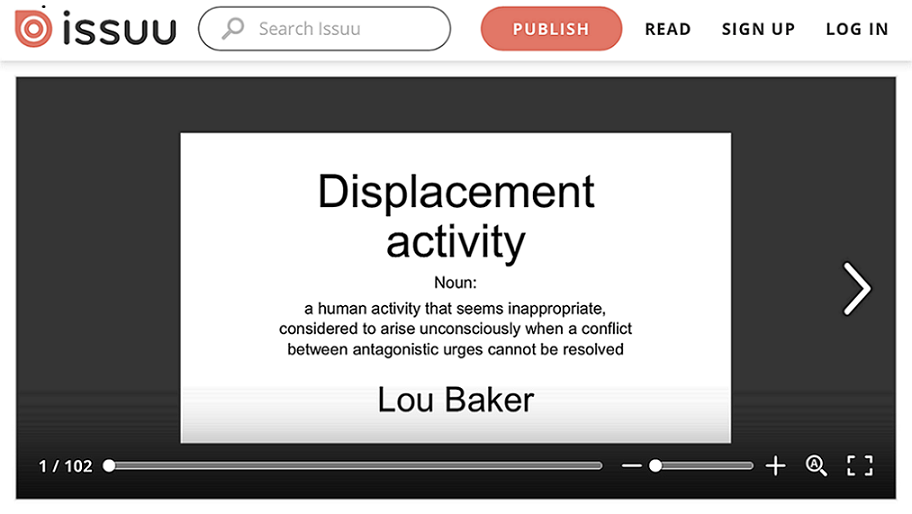
The displacement activities are:
Displacement activity #1: Pill packets and Post-its
Displacement activity #2: Mobile soft sculptures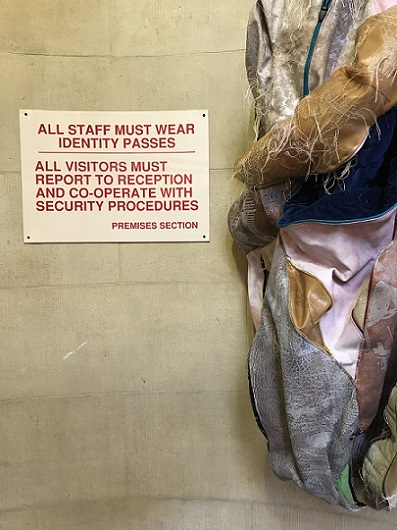
Displacement activity #3: Roaming sleeping bag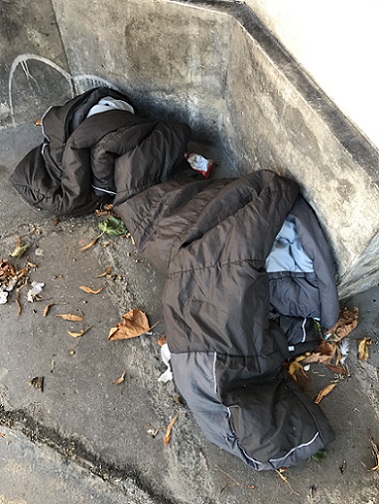
Click to watch a video of Displacement activity #4: Drawing in space with elastic …. (and a monkey)
Click to watch a video of Displacement activity #5: Helium balloons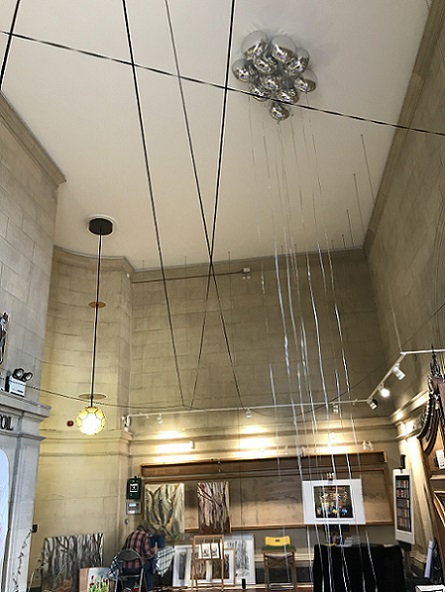
Displacement activity #6: Helium balloons and mirrors
Displacement activity #7: Look up, look down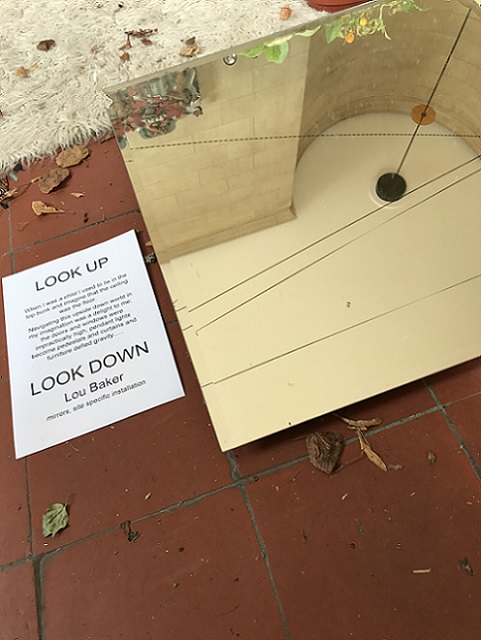
Displacement activity #8: Pill packets and hair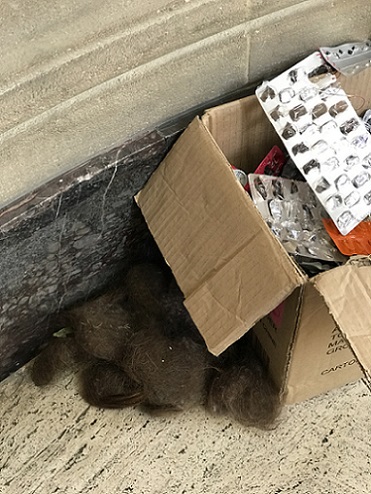
Displacement activity #9: Sculpting with pill packets and a stapler
Displacement activity #10: Shadows, light and reflections
Click to watch a video of Displacement activity #11: Collaborative drawing
Click to watch a video of Displacement activity #12: Projection 1
and click to watch a video of Displacement activity #12: Projection 2
Have a look at the documentation of Displacement activity here.
Read about Safety net at The Vestibules - I set it up and left it to do what it does for the 4 weeks of the residency. Here is a video showing how one participant responded.
#whatdoartistsdoallday #everydayisdifferent
@loubakerartist



